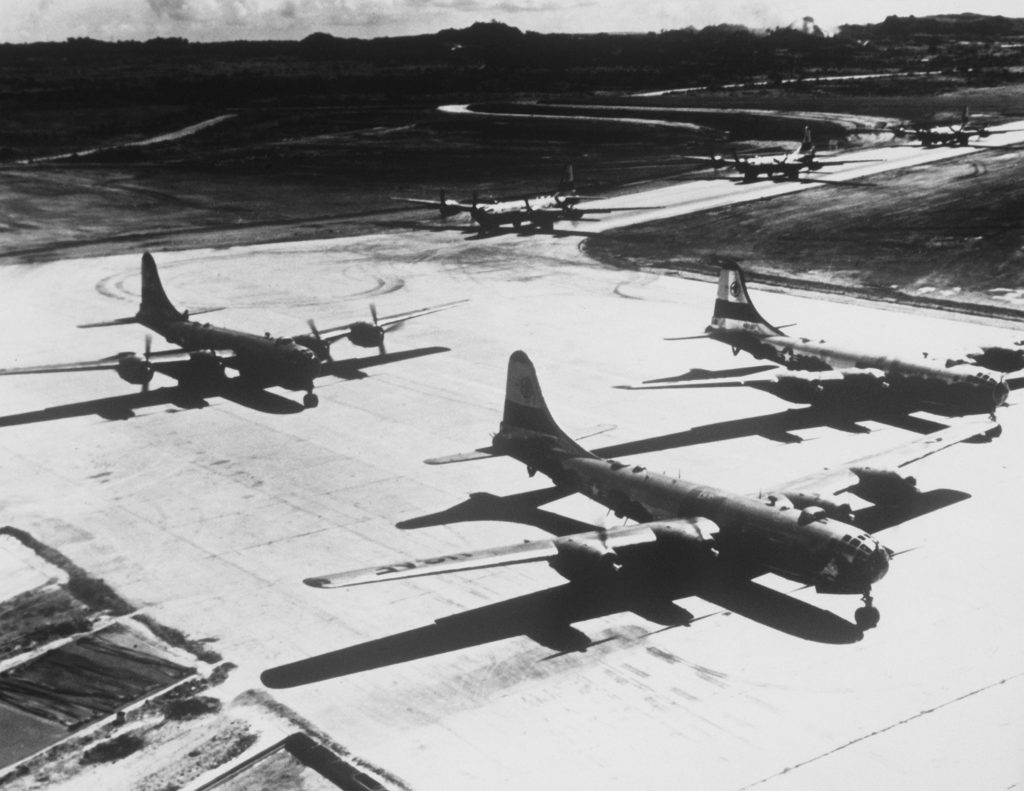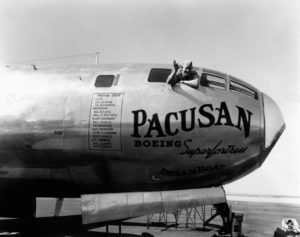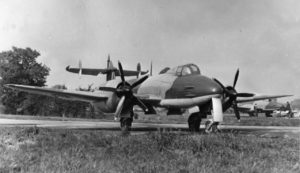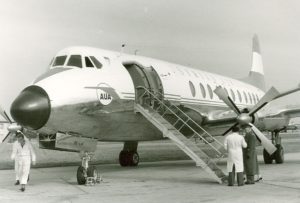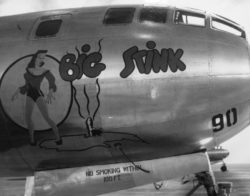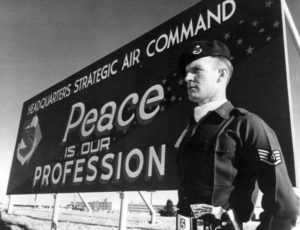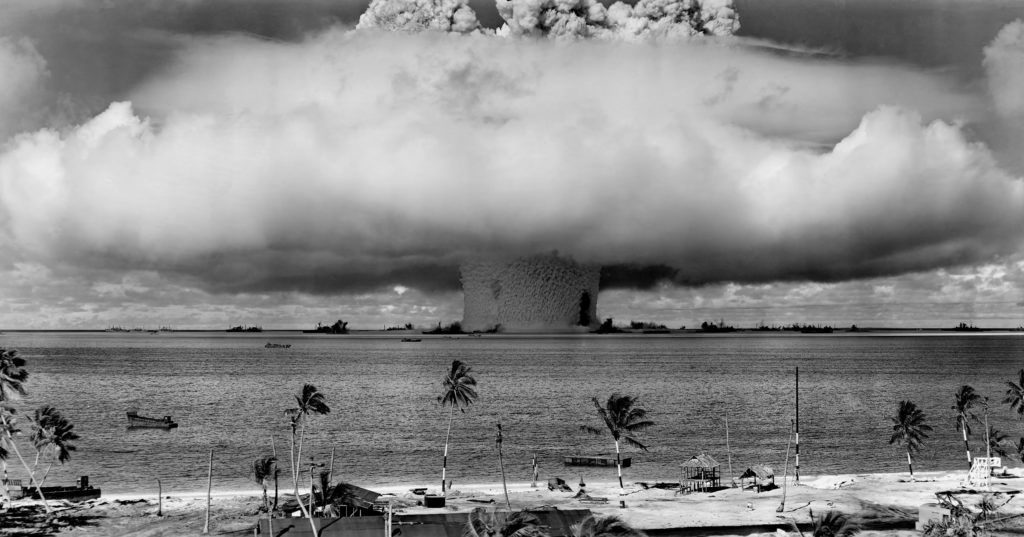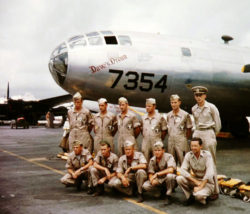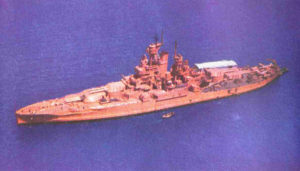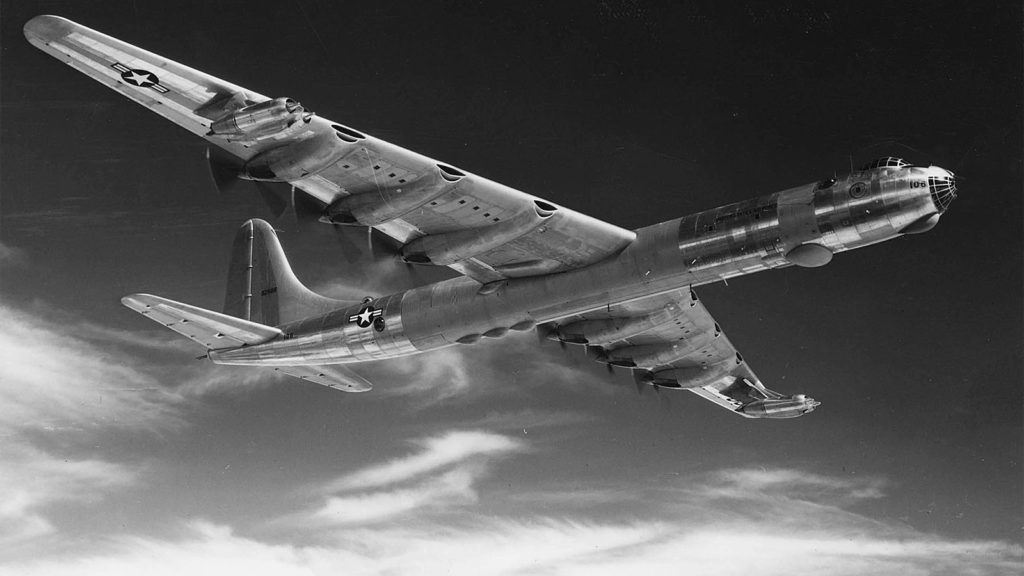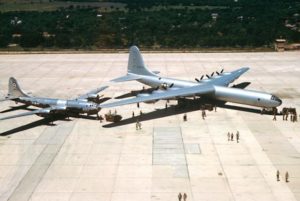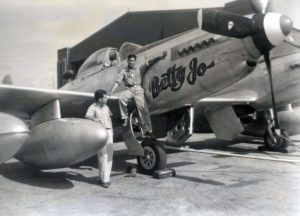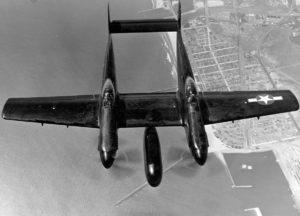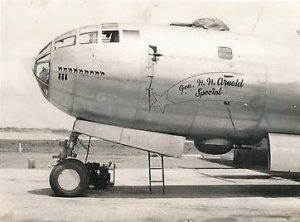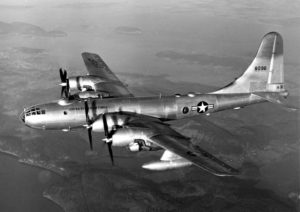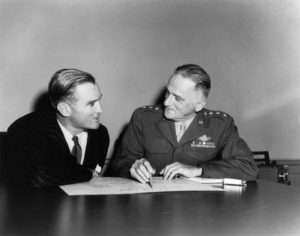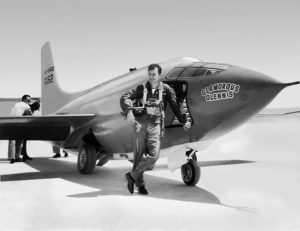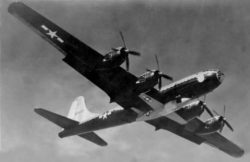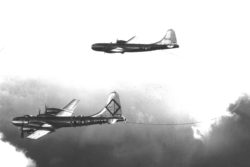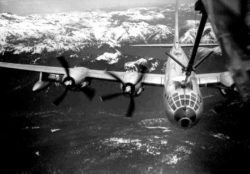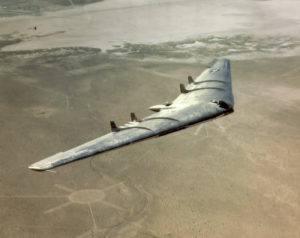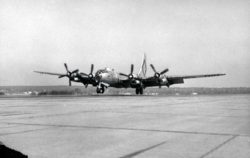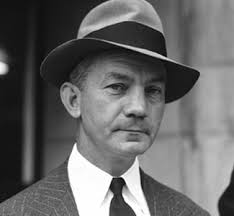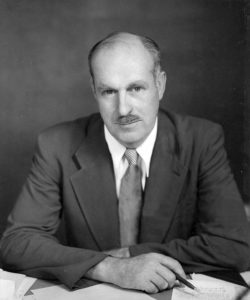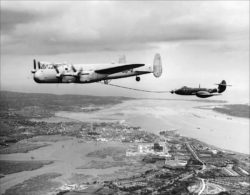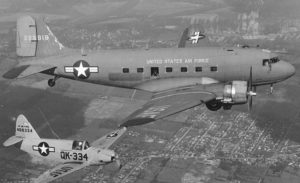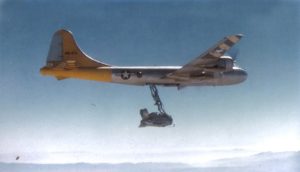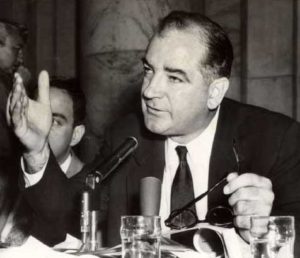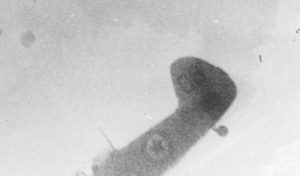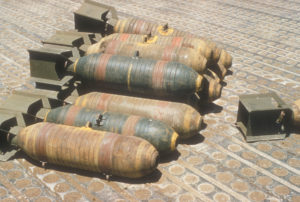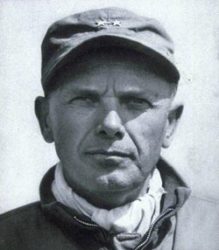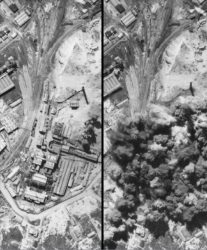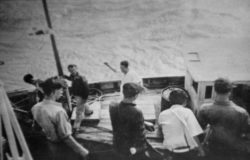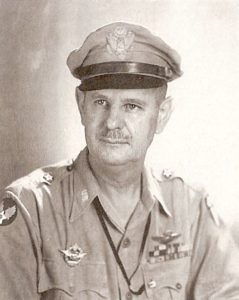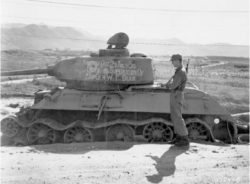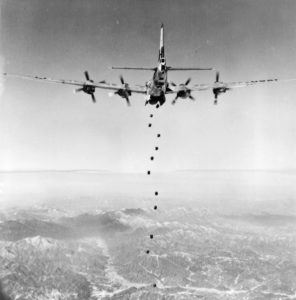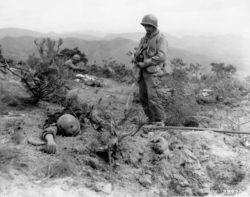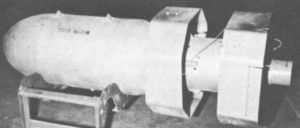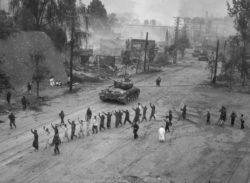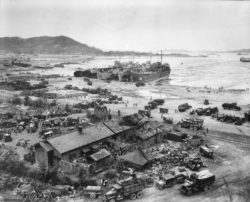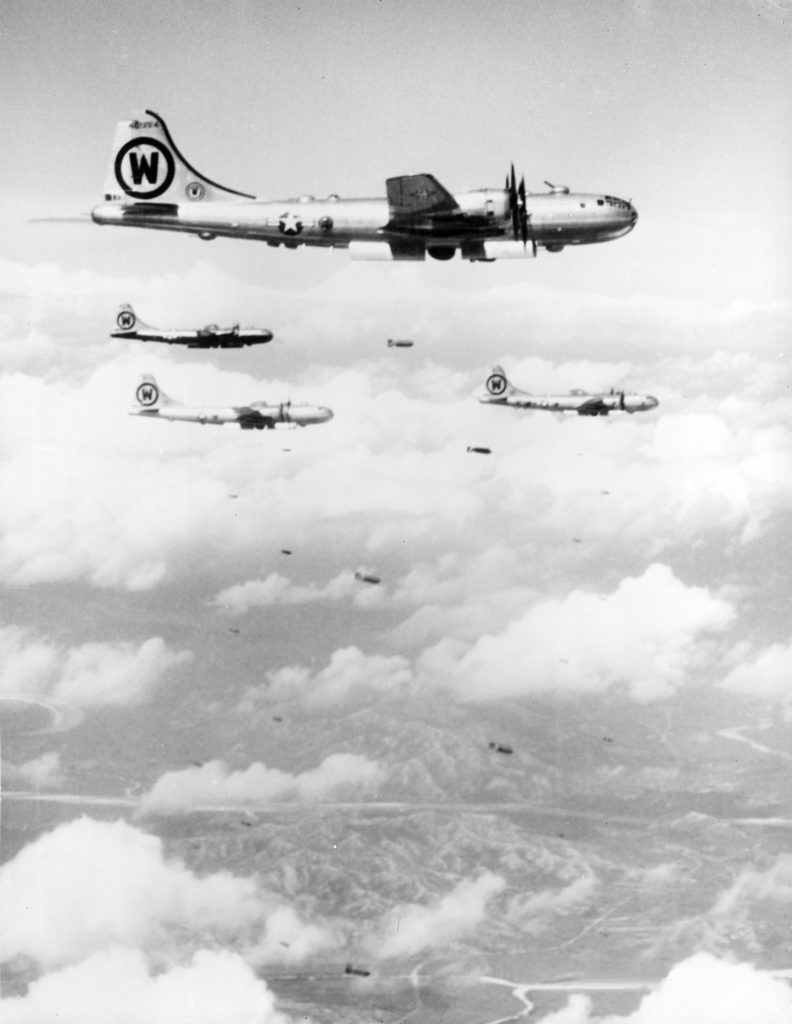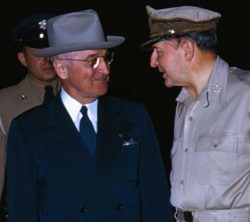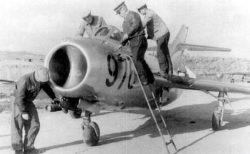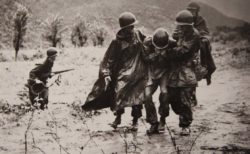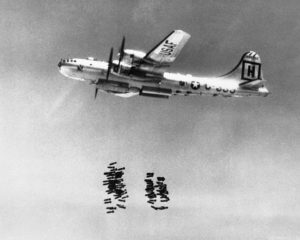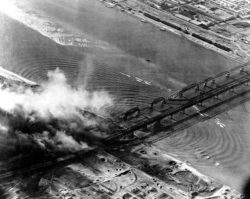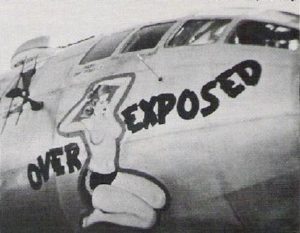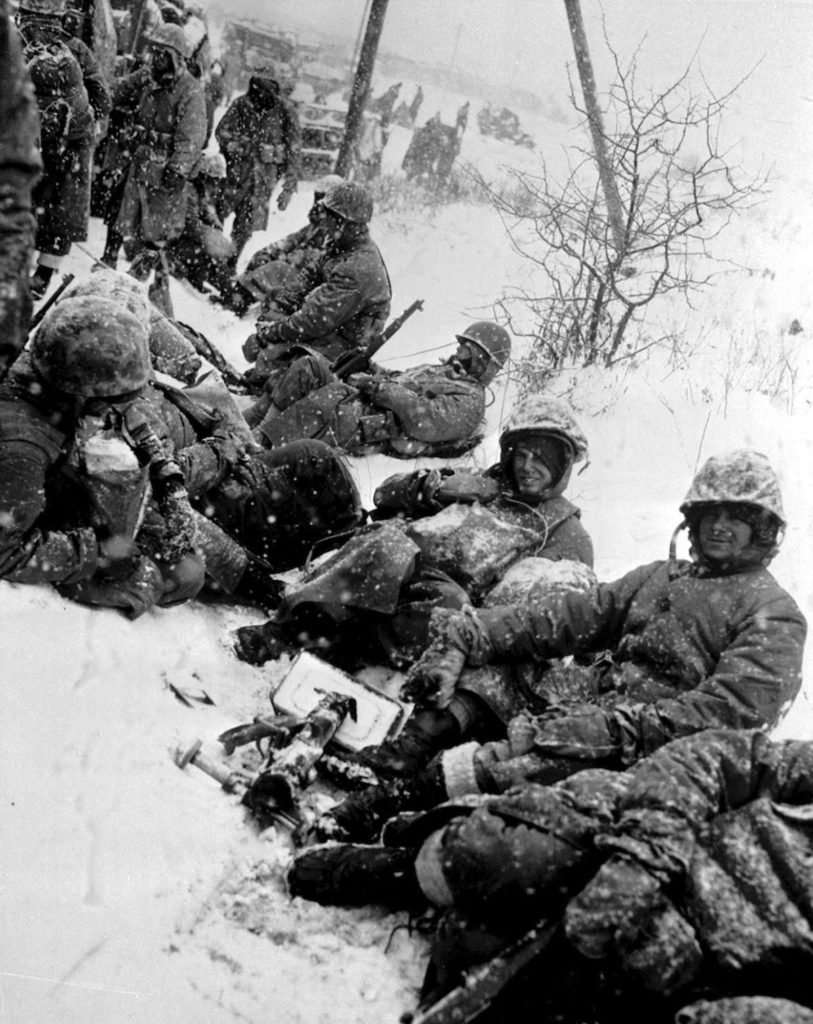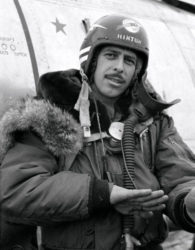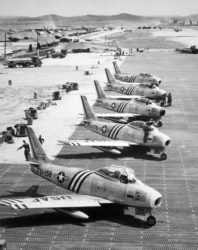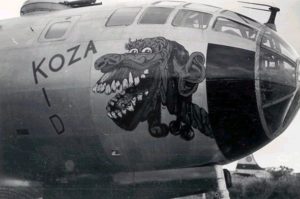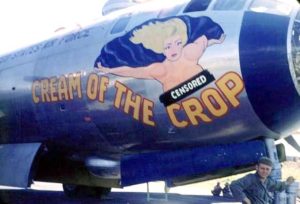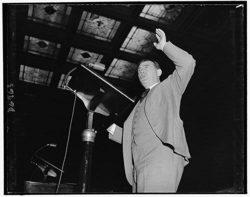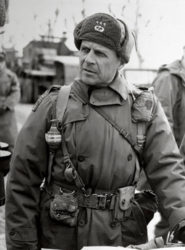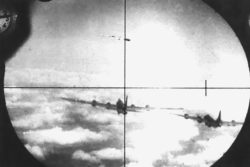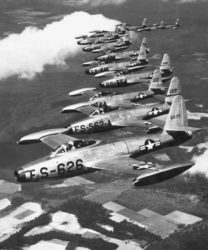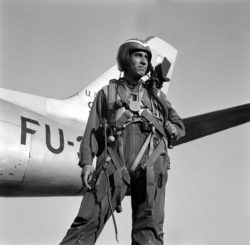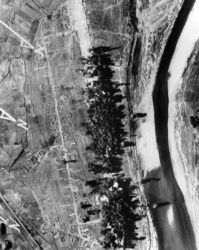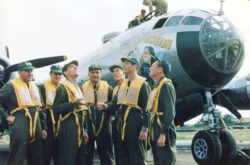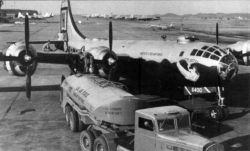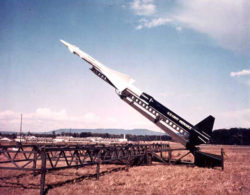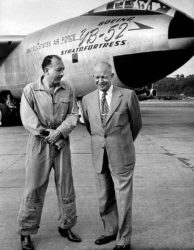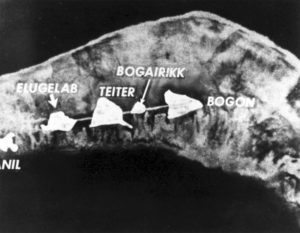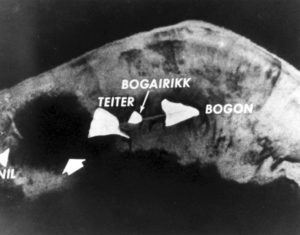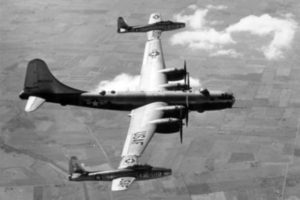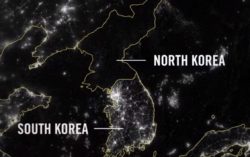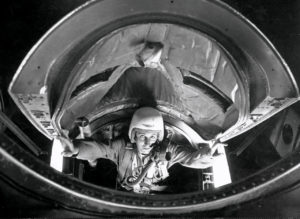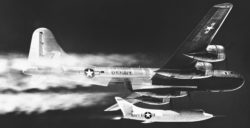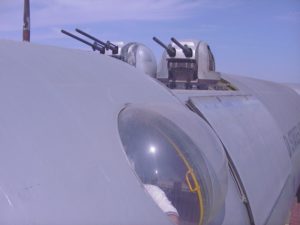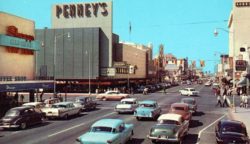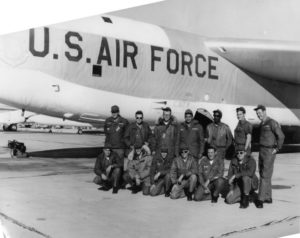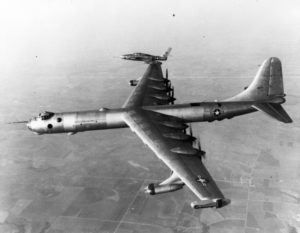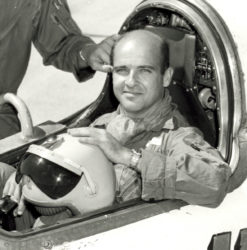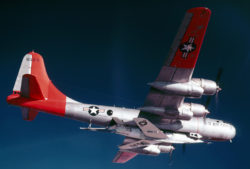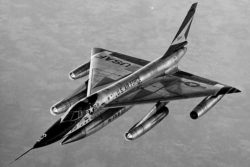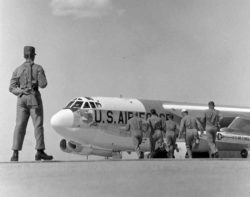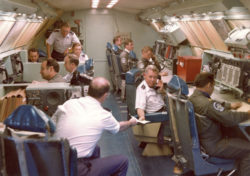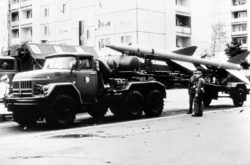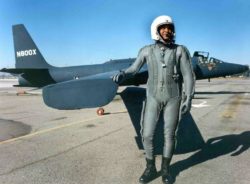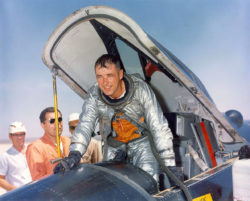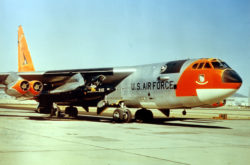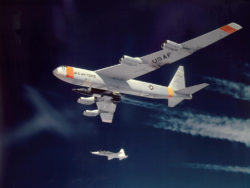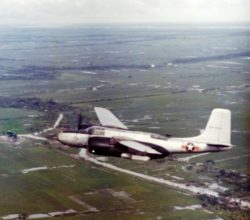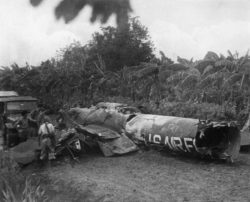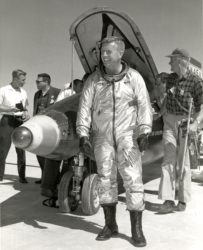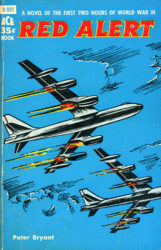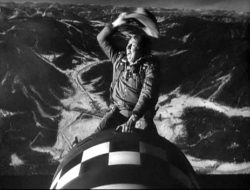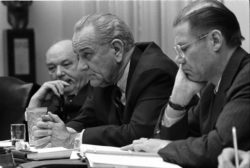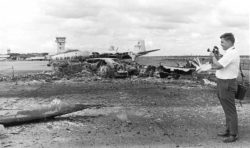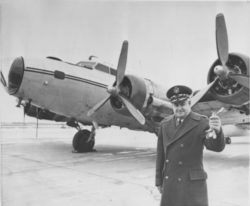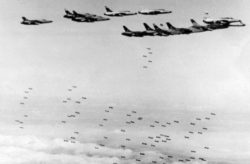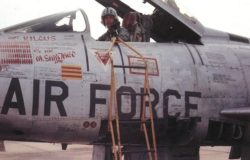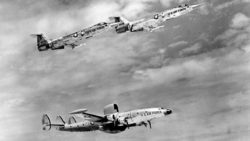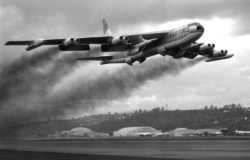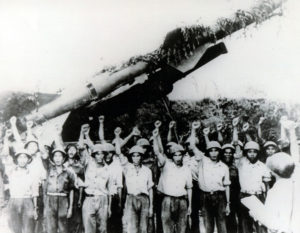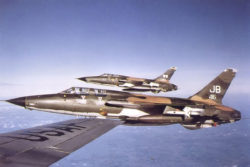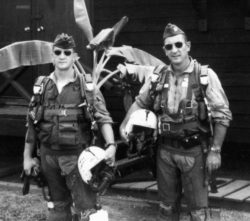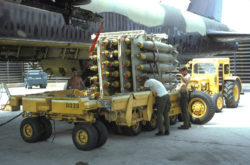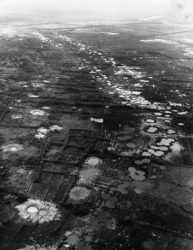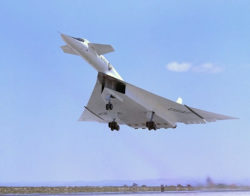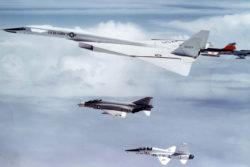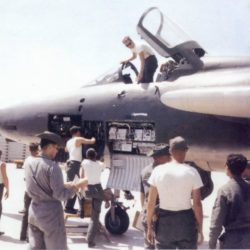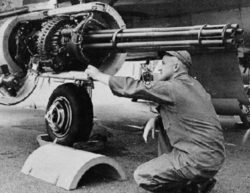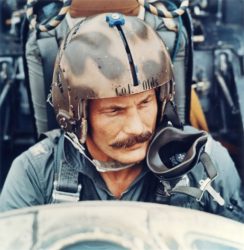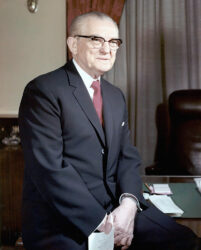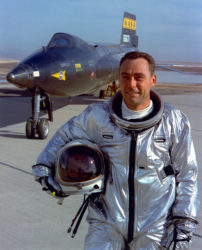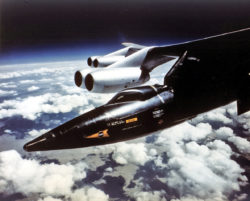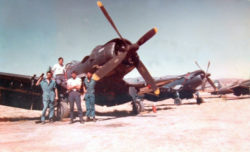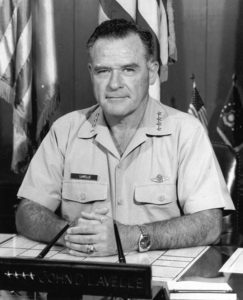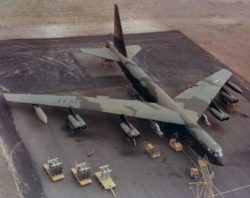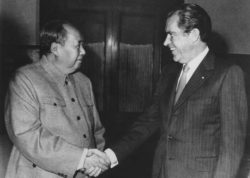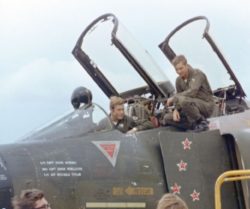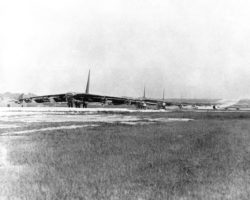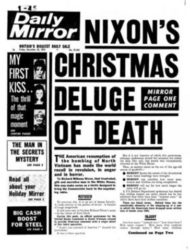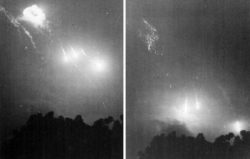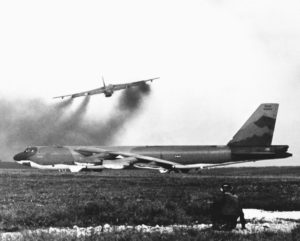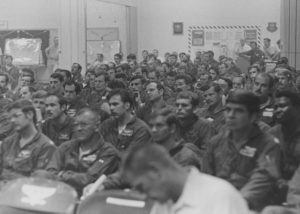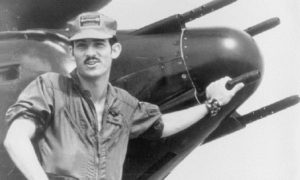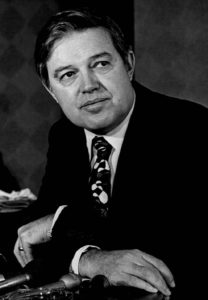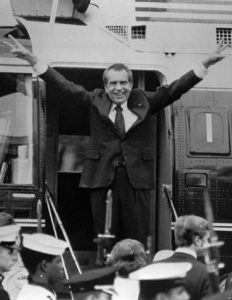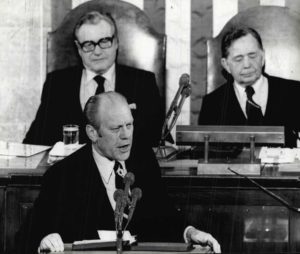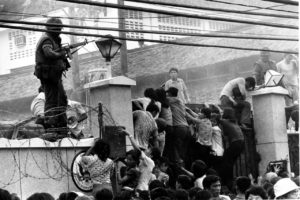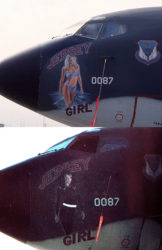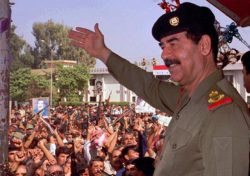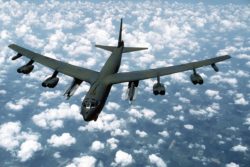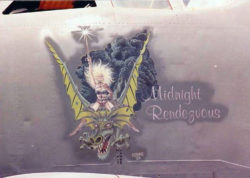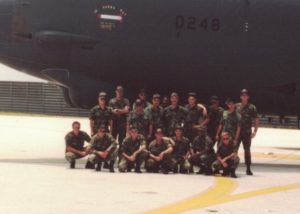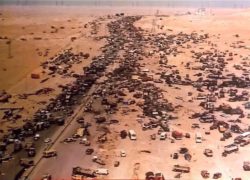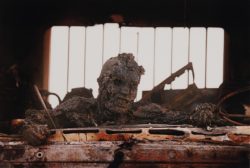Timeline of Strategic Aviation
Second World War
Cold War
1946-1991
19 September 1945
In a show-of-force against the Soviet Union, three Boeing B-29s of the US 20AF attempt to fly nonstop from Chitose, Japan to Washington, DC. Each of the modified aircraft is flown by a general officer: LTG Barney M. Giles (XO USASTAF), MG Curtis E. LeMay (CS USASTAF), and BG Emmett E. O’Donnell, Jr (CG 73BW). The bombers fly some 6,500 mi before unexpected headwinds force them to land and refuel in Chicago, IL. Despite the flight's failure to break the distance record (7,162 mi), the secondary objective is accomplished: the bombers were at one point intercepted during Soviet Bell P-63s, demonstrating the USAAF's ability to reach the Soviet Union. (27 hr, 28 min)
On 20 November 1945 another B-29B, Pacusan Dreamboat (44-84061, 331BG), successfully breaks the distance record, flying from Guam to Washington, DC nonstop in 35 hr, 5 min. This flight, commanded by XO XXI BC COL Clarence S. Irvine, covers 7,916 mi and is done with a similarly altered B-29. Several other record-breaking attempts using B-29s are launched throughout the following year, almost all of which use SILVERPLATE-type aircraft. The most important of these occurs on 15 May 1946 when CS PACAF BG BG Frank A. Armstrong flies Fluffy Fuzz IV (44-84065, 501BG) to an altitude of 47,910 ft with a 2,200 lb load - a record that stands to this day.
20 September 1945
The first flight of a turboprop aircraft take places with the special conversion of Gloster Meteor EE227. While the turboprop concept was first patented by Hungarian engineer György Jendrassik in 1929 and tested in 1940, the German war effort prevented Jendrassik from making further headway. In contrast to piston engines, turboprops use turbines to spin the propeller, and while tests such as this prove the concept's feasibility, turboprop designs fail to arouse significant interest due to the concurrent rise of jet technology.
The first mass-produced turboprop aircraft is the Vickers Viscount, entering mass-production in 1953. Some 445 examples are produced of this 75 passenger airliner before its retirement in 1964. To better give an idea as to where the turboprop stands in regard to performance standards of the period, it is perhaps best to compare the Vickers Viscount to the contemporary Douglas DC-7 and the de Havilland Comet. The DC-7 is the last of the great piston engine airliners and as such, stands as an example of the best in piston-engine technology. Conversely, the de Havilland Comet is the first of the mass-produced jet airliners. All three aircraft enter service in 1953.
| Vickers Viscount | |
| Maximum Speed: | 352 mph |
| Service Ceiling: | 25,000 ft |
| Range: | 1,380 mi |
| Douglas DC-7 | |
| Maximum Speed: | 405 mph |
| Service Ceiling: | 28,400 ft |
| Range: | 3,565 mi |
| de Havilland Comet | |
| Maximum Speed: | 450 mph |
| Service Ceiling: | 42,000 ft |
| Range: | 1,496 mi |
7 March 1946
The Atomic Energy Commission holds a competition near Albuquerque, NM to determine which bomber crew will be given the honor of dropping a nuclear weapon over Bikini Atoll in the Marshall Islands. CG 58BW BG Roger M. Ramey, under pressure from G-3 20AF COL William Blanchard, conceived the competition to prevent CO 509BG COL Paul W. Tibbets, Jr. from being automatically assigned the Bikini operation. Blanchard harbored resentment over the special status of the 509BG and the publicity Tibbets received as its commander since 1945. Naturally, any airmen associated with a nuclear strike would receive great public attention, and Blanchard and Ramey take advantage of this situation.
Using Pumpkin bombs, a series of test runs are made outside of Albuquerque, with Tibbets and his crew coming in first place. Operations analysts contest the findings, arguing that, had the jet stream over the southwestern US been similar to that of the central-Pacific, Tibbets and his crew would have missed the target completely. Instead, the third place winner, Big Stink (44-27354), is selected for the drop. After the competition the bomber is renamed Dave’s Dream in honor of CPT David Semple, who was killed during the competition when his Boeing B-29 (42-65387) failed to properly execute a PTT, the tail being sheared away by the excessive G-force. This accident is indicative of the inadequate training given to many of the flight crews – a portent of things to come.
21 March 1946
Upon the recommendation of a board chaired by GEN William H. Simpson, CSA GA Dwight D. Eisenhower and CG USAAF GEN Carl A. Spaatz (both newly appointed), oversee the reorganization of the USAAF. During the war, Spaatz commanded both USSTAF and USASTAF, which saw numbered air forces divided into purpose-based commands in Europe and the Pacific, respectively. It is their intention to apply this model to the service as a whole. As such, the USAAF is divided into commands: Strategic Air Command (GEN George C. Kenney), Tactical Air Command (MG Elwood R. Quesada), Air Defense Command (LTG George E. Stratemeyer), Air Materiel Command (LTG Nathan F. Twining), Air Transport Command (LTG Harold L. George), Air Training Command (LTG John K. Cannon), and Air University (MG Muir S. Fairchild).
Due to its nuclear strike capability, SAC's importance in this arrangement is undisputed. However, due to the pressures of postwar demobilization, all of the commands suffer from poor performance in the coming years.
1 July 1946
US Pres. Harry S Truman (D-MO) approves Operation CROSSROADS wherein some 95 ships, including retired capital ships and Axis war prizes, are arranged in the Bikini Atoll of the Marshall Islands for nuclear weapons testing. Reminiscent of BG Billy Mitchell's 'battleship trials' 20 years prior, the USN and USAAF are eager to prove their funding-worth at Bikini. On this date, the first of two strikes (Test Able) is made, dropping a plutonium-based nuclear weapon, Gilda, from the Boeing B-29 Dave’s Dream (44-27354).
The Bikini tests do not go well. The crew of Dave's Dream miss their target, the USS Nevada (BB-36), by an embarrassing 1,800 ft, which later results in the crew being investigated by the FBI. The bombardier of Dave's Dream, MAJ Harold H. Wood, was previously warned by MAJ Tom F. Ferebee and MAJ Kermit K. Beahan - the bombardiers of the Hiroshima and Nagasaki strikes - that his calculations were woefully off, predicting he would miss by some 1,600 ft. The accuracy of their advice, and the subsequent failure of Dave's Dream to follow it, is a major embarrassment to the USAAF and the incident is quickly buried.
Test Baker, conducted on the 25th, detonates 180 ft below water, resulting in massive radioactive fallout and forcing an end to further tests at Bikini until 1954. Sailors who participate in the tests are later found to suffer high rates of cancer and radiation poisoning, resulting in a press-nightmare worsened by the new-found inability of Bikini natives to return home. The only saving grace of the tests comes from French fashion designer Louis Réard, who names his new two-piece swimsuit design after the tests. A two-piece swimsuit, Réard claims, can only be called a "bikini" if it can be pulled through a wedding ring.
Click here to see model Micheline Bernardini pose in the original bikini with its box.
8 August 1946
The first flight of the Consolidated-Vultee (Convair) B-36 Peacemaker takes place. Originally ordered during the Second World War as a safety-precaution should Great Britain fall, the B-36's intercontinental strike ability makes it an absolute necessity in the early years of the Cold War - particularly in light of the poor state of aerial refueling. Massively heavy to the point that it requires four jets in addition to its six piston-engines to takeoff, the bomber generates severe criticism as an outdated design at the dawn of the jet age. The bomber's range negates this issue and USAAF officers are quick to point out the B-36's incredible altitude performance. No B-36 ever sees combat, though they see significant service as a reconnaissance platform and in simple shows-of-force. When the introduction of the MiG-15 Fagot over Korea brings an end to the piston-engine bomber, the B-36 is begrudgingly held on by the Eisenhower administration until it can be replaced by the Boeing B-52 and as a reconnaissance platform by the Lockheed U-2. In all, some 334 B-36s are built, staying in service until 12 February 1959.
Four Convair B-36 Peacemakers currently survive in various museums, though only one, 52-2220, is in pristine condition, being on display at the National Museum of the US Air Force in Dayton, OH.
| Powerplant: | 6x Pratt & Whitney R-4360 28-Cylidner Four-Row |
| 3,870 lb 4,300 hp Turbocharged Piston Engines | |
| 2x General Electric J47 | |
| 2,554 lb 5,970 lbf Axial-Flow Turbojets | |
| Armament: | 8x Hispano-Suiza M24 20 mm Autocannon |
| Bombload: | 72,000 lbs |
| Cruise Speed: | 230 mph |
| Service Ceiling: | 43,600 ft |
| Range: | 8,175 mi |
27 February 1947
COL Robert E. Thacker and 2LT John M. Ard fly North American P-82 Betty Jo (44-65168) from Pearl Harbor, HI to New York, NY without stopping. The flight covers 5,051 mi at an average speed of 347 mph, setting a record for the longest nonstop flight by a propeller-driven fighter aircraft, as well as the fastest such a distance record has ever been made. (14 hr, 32 min)
Produced too late to see wartime action, the P-82 was originally designed as an escort for the Boeing B-29. The arrival of the Tupolev Tu-4 later sees the P-82 become a fighter interceptor, attaching a radar pod between the fuselages (“Long Dong”) and converting one of the cockpits to carry a Radar Information Officer (RIO).
The North American P-82 Betty Jo is currently on display at the National Museum of the US Air Force in Dayton, OH, where it is one of two P-82s on display.
| Powerplant: | 2x Allison V-1710 Liquid-Cooled 12-Cylinder |
| 1,395 lb 1,500 hp Supercharged Piston Engines | |
| Armament: | 6x Browning M3 .50 Caliber MGs |
| Cruise Speed: | 286 mph |
| Service Ceiling: | 38,900 ft |
| Range: | 1,390 mi |
10 May 1947
The first flight of the Tupolev Tu-4 takes place. Using Boeing B-29s that made emergency landings at Vladivostok during the Second World War, Tupolev OKB was under personal order from Premier Joseph V. J. Stalin to produce a copy of the bomber. Alongside programs to develop the MiG-15 jet fighter and Izdeliye 501 nuclear weapon, the Soviet Union, using the B-29 and the Rolls-Royce Nene jet engine as templates, become a first-rate airpower in a period of less than three years. Visually identical to the B-29 in every way, the Tu-4 is first revealed to the world during a parade on 7 August - though claims are made that the bomber's resemblance is a mere coincidence. The UN gives the Tu-4 the codename Bull (for obvious reasons) and with it the Soviet Union now has a bomber capable of reaching the United States. Some 847 Tu-4s are built and they serve both the Soviet Union and communist China in various roles until retired in 1988.
Three Tu-4 Bulls currently survive in various museums, though only one, 2805103, is in its original configuration, being displayed outdoors at the Central Air Force Museum near Moscow, Russia.
| Powerplant: | 4x Shvetsov Ash-73 Air-Cooled 18-Cylinder Two-Row |
| 2,951 lb 2,400 hp Turbocharged Piston Engines | |
| Armament: | 10x Nudelman-Rikhter NS-23 23 mm Autocannon |
| Bombload: | 20,000 lbs |
| Cruise Speed: | 224 mph |
| Service Ceiling: | 36,745 ft |
| Range: | 4,100 mi |
| Aircraft Type | Serial No. | Name | Code | Unit | Date |
| Boeing B-29-5-BW | 42-6256 | Ramp Tramp | unk | 771BS/462BG | 29-Jul-44 |
| Boeing B-29-15-BW | 42-6365 | Hap Arnold Special | unk | 794BS/468BG | 12-Nov-44 |
| Boeing B-29-15-BW | 42-6358 | Ding Hao! | unk | 794BS/468BG | 21-Nov-44 |
25 June 1947
The first flight of the Boeing B-50 Superfortress II takes place. Designed as a means of correcting the problems that plagued the Boeing B-29, the B-50 is in reality little more than a B-29 variant. In fact, the original designation - B-29D - was dropped simply as a ruse to receive funding in response to B-29 order cancellations. The B-50 is virtually identical to the B-29 except for changes to the engines, stabilizer, and forward turret, and the addition of external fuel tanks. No B-50 ever sees combat, instead they supplement the Convair B-36 and Boeing B-47 as nuclear strike aircraft, the remaining B-29s all reverting to their traditional bombardment roles. Some 370 B-50s are built and they serve as a mainstay of SAC until retired in 1965.
Three Boeing B-50 Superfortress IIs currently survive in various museums, though only one, 49-0310, is in pristine condition and displayed indoors, being on display at the National Museum of the US Air Force in Dayton, OH.
| Boeing B-29 | |
| Powerplant: | 4x Wright R-3350 Air-Cooled 18-Cylinder Two-Row |
| 2,670 lb 2,200 hp Turbocharged Piston Engines | |
| Armament: | 12x Browning AN-M2 .50 Caliber MGs |
| 1x Hispano-Suiza M24 20 mm Autocannon | |
| Bombload: | 20,000 lbs |
| Cruise Speed: | 220 mph |
| Service Ceiling: | 33,600 mph |
| Range: | 5,600 mi |
| Boeing B-50 | |
| Powerplant: | 4x Pratt & Whitney R-4360 Air-Cooled 28-Cylinder Four-Row |
| 3,870 lb 4,300 hp Turbocharged Piston Engines | |
| Armament: | 12x Browning AN-M2 .50 Caliber MGs |
| Bombload: | 20,000 lbs |
| Cruise Speed: | 244 mph |
| Service Ceiling: | 36,650 ft |
| Range: | 5,762 mi |
18 September 1947
US Pres. Harry S Truman (D-MO) signs the National Security Act of 1947. Truman seeks to correct much of the corruption he investigated as a Senator by reorganizing the American military, completely placing it under civilian control. The Navy and War Departments are merged under a single Secretary of Defense, the latter department now being renamed the Department of the Army (this arrangement is clarified somewhat in 1949). Also included in the Act is the creation of the National Security Council (NSC) and the Central Intelligence Agency (CIA). The first Secretary of Defense is former Secretary of the Navy James Forrestal (D-NY) and the first CIA Director is retired GEN W. Bedell Smith (IN).
Perhaps the most significant creation of the National Security Act is an independent US Air Force (USAF), it too having its own department. Fittingly, Truman signs the bill aboard his private aircraft, Douglas C-54 Sacred Cow (42-107451) - the first "Air Force One." W. Stuart Symington, Jr. (D-MO), former president of gun-turret producer Emerson Electric, is appointed Secretary of the Air and Gen Carl A. Spaatz is appointed the first CSAF. Spaatz does not hold the office for long, retiring shortly after his 57th birthday on 30 June 1948. He is replaced by the controversial young Gen Hoyt S. Vandenberg.
14 October 1947
Capt Chuck E. Yeager pilots the first officially recorded flight faster than the speed of sound (700 mph, Mach 1.06), flying the Bell X-1 Glamorous Glennis (46-062), dropped from Boeing B-29A 45-21800, above Muroc AFB. Yeager is awarded the 1947 MacKay Trophy for this feat.
Essentially a giant bullet, the X-1 heavily benefits from British research and development. The British program was built around the Mile M.52, and while the aircraft was never actually built, the concept successfully introduced the need for a low-drag, thin wing and stabilator (i.e., a moving tailplane in place of a hinged elevator). When Geoffrey R. de Havilland, Jr. was killed on 27 September 1946 flying a de Havilland DH 108 (a Me-163 inspired design), the Royal Aircraft Establishment halted its supersonic program, passing its research on to NACA where it was applied to the Bell X-1. De Havilland's death shocked the aviation world and arose fears that the so-called "sound barrier" could not be broken. The news of Yeager's achievement eventually leaks to the press and is first published in the 20 December issue of Aviation Week.
The Bell X-1 Glamorous Glennis is currently on display at the National Air and Space Museum in Washington, DC.
The breaking of the sound barrier is later dramatized in the film The Right Stuff (1983), starring Sam Shepard as CPT Chuck E. Yeager and Levon Helm as project engineer MAJ Jack L. Ridley. Based on a book by Tom K. Wolfe, Jr., The Right Stuff goes beyond the sound barrier to cover the entirety of the Mercury space program (1957-1963). In doing so, the film is more than a narrative of past events; rather, it serves as a polemic on the changing manner in which American culture defines heroism.
28 March 1948
The USAF completes its first trial with a licensed copy of Flight Refueling Ltd.'s grappled-line, looped hose aerial refueling system, using a pair of Boeing B-29s. CSAF Gen Carl A. Spaatz made aerial refueling a top priority on 26 February, the idea being to increase the number of US bombers capable of striking the Soviet Union. The grappled-line, looped hose system is infamously clumsy and Flight Refueling is already working on a successor, but the older system is nevertheless purchased due to it being the only proven method yet designed. The success of these tests sees the creation of two dedicated tanker units, the 43ARS and 509ARS, on 30 June, and the requirement is made that all subsequent US bomber aircraft have air-refueling capability. Some 74 B-29s are also altered to receive grappled-line, looped hose refuelings, though this is frowned upon as it requires the removal of one of the aircraft's bombbays to hold a receiver tank. As such, the B-29 is slowly relegated to secondary roles, with newer bombers taking up the brunt of SAC. Some 92 B-29s are converted into dedicated tanker aircraft.
15 May 1948
Air Materiel Command requests Boeing begin research into aerial refueling, following up on a concept first made by B. A. Holman. The resultant design, the "flying boom," is successfully tested on 16 September. The flying boom is significantly easier to operate than the grappled-line, looped hose system. The design functions thusly: a telescopic pole apparatus is mounted beneath the tail of the tanker aircraft, the 'boom operator' controlling the apparatus using wing-canards which allow him to guide the boom into linking with the receiver aircraft. The requirements for the receiver are merely to comply with the tanker's instructions to stay in position. The advantages of the boom system are readily apparent, greatly increasing rate-of-transfer and cutting down on aerodynamic drag. Some 116 Boeing B-29s are converted into boom-equipped tankers, the first being assigned to the 97BW at Biggs AFB near El Paso, TX on 1 September 1950. The flying boom system is still in use to this day.
5 June 1948
A newly-designed jet version of the Northrop XB-35, the Northrop YB-49, disintegrates above Muroc AFB, killing its five-man crew. Topeka AFB is renamed Forbes AFB and Muroc AFB is renamed Edwards AFB after the aircraft’s pilots. The next two years see more problems with the YB-49's handling and the contract is eventually cancelled, but not without controversy. When Secretary of Defense James Forrestal (D-NY) is sacked in 1949, his replacement, Louis A. Johnson (D-WV) cancels development of the YB-49. Embarrassingly, it is revealed that Johnson was formerly on the board of directors at Convair - the company responsible for XB-35/YB-49's competitor, the B-36 Peacemaker.
| Northrop XB-35 | |
| Powerplant: | 4x Pratt & Whitney R-4360 Air-Cooled 28-Cylinder Four-Row |
| 3,870 lb 4,300 hp Turbocharged Piston Engines | |
| Armament: | 20x Browning M3 .50 Caliber MGs |
| Bombload: | 16,000 lbs |
| Cruise Speed: | 183 mph |
| Service Ceiling: | 39,700 ft |
| Range: | 8,140 mi |
| Northrop YB-49 | |
| Powerplant: | 8x General Electric/Allison J35 |
| 2,315 lb 5,600 lbf Axial-Flow Turbojets | |
| Armament: | 4x Browning M3 .50 Caliber MGs |
| Bombload: | 16,000 lbs |
| Cruise Speed: | 365 mph |
| Service Ceiling: | 45,700 ft |
| Range: | 9,978 mi |
2 March 1949
Boeing B-50 Lucky Lady II (46-0010, 43BG) completes the first around-the-world flight of an aircraft without landing. Having headed eastward from Fort Worth, TX, the bomber flew some 23,452 mi, being refueled throughout its journey by four KB-29s using the grappled-line looped-hose system. Said fuel system performed poorly during the flight and further use of the grappled-line looped-hose system is cancelled in favor of the flying boom type. As a means of combating fatigue, the bomber carried a double-strength crew, rotating shifts on an average of every 5 hrs. The flight is a media success in demonstrating the USAF’s new-found global strike ability. The crew of Lucky Lady II are awarded the 1949 MacKay Trophy for this feat. (94 hr, 1 min)
The Boeing B-50 Lucky Lady II currently sits in the desert in pieces, though it is the property of the Planes of Fame Air Museum in Chino, CA.
23 April 1949
Secretary of Defense Louis A. Johnson (D-WV) cancels construction of the aircraft carrier USS United States (CVA-58) five days after the keel is laid. Secretary of the Navy John L. Sullivan (D-NH) immediately resigns in protest, the first act of a media fiasco known as the “Revolt of the Admirals.” The controversy originated with the firing of the previous Secretary of Defense, James V. Forrestal (D-NY). Forrestal clashed with Pres. Harry S Truman (D-MO) over Truman's military budget cuts, and when Forrestal was exposed by reporter Drew R. Pearson for having private meetings with Republican presidential nominee Thomas E. Dewey (R-NY) in 1948, Truman had him sacked. Forrestal was later found dead, apparently having jumped from the 16th floor of Bethesda Naval Hospital while undergoing psychiatric treatment.
Hearkening to the Second World War, each service branch proclaims themselves to be the “war-winning” service in attempt to secure more funding. The Air Force and Navy both feel that they played decisive roles in the victory through their use of strategic bombers (particularly in the nuclear-strike role) and aircraft carriers, respectively. As such, they use this rationale to justify ostentatious spending on the Convair B-36 and the USS United States - a massive, though poorly conceived, aircraft carrier capable of launching jet fighters and nuclear-capable multi-engine bombers. Johnson, Forrestal’s replacement, eagerly implemented Truman’s budget cuts by favoring the Air Force over the Navy. Despite the massive funds this frees, the cancellation of the USS United States results in an uproar from the Navy Department. CNO ADM Louis E. Denfield calls for an investigation, led by CPT Arleigh A. Burke, into the B-36's flight performance, RDML Daniel V. Gallery publishes an article in the Saturday Evening Post titled “Don’t Let Them Scuttle The Navy!,” and most scandalous of all, CDR Cedric R. Worth (Ret.) reveals to the press that Johnson was once on the board of directors at Convair.
Following a lengthy Congressional investigation into the affair which reaffirms Johnson’s decision, Sullivan’s replacement for Secretary of the Navy, Francis P. Matthews (D-NE), implements a policy of punishing those within the Navy responsible for the media fiasco. While the “Revolt of the Admirals” is heralded as a victory for civilian control of the military, the coming of the Korean War in 1950 reveals the shortcomings of such drastic defense cuts. The new USAF, for example, which had been planned as a postwar force of 70 groups (17,849 aircraft), is composed of a mere 48 groups (6,869 aircraft) in 1950. As such, the US military, which boasted an unprecedented might just five years prior, ultimately struggles to hold back qualitatively inferior Chinese and North Korean forces during much of the Korean War. Made a scapegoat, Johnson is held responsible for this and he too is sacked by the Truman administration in 1950.
7 August 1949
Pat Hornidge, a test pilot with Flight Refuelling Ltd., sets the endurance record for longest jet-powered flight, orbiting Gloster Meteor Mk. III EE397 over the the Isle of Wight and refueling via a converted Avro Lancaster. This achievement is a publicity stunt for Sir Alan J. Cobham’s new "probe and drogue" refueling system. Cobham sold the rights to his grappled-line, looped-hose system to the US under the realization that neither the RAF or BOAC held any serious interest in it. Aware of its deficiencies, Cobham altered the design to remove the necessity of a dedicated refueling engineer aboard the receiver aircraft. The probe and drogue worked thusly: a fuel line is spooled out behind the tanker aircraft with a conical tip, with the receiver guiding a probe into the cone to complete the mating process. First tested on 4 April 1949, Cobham hoped to counter the success of Boeing's flying boom by catering to fighter aircraft, who found his system easier to use. The USAF's grappled-line, looped hose equipped Boeing KB-29s are altered to the probe and drogue system and see heavy usage in TAC until phased out in favor of flying booms. Conversely, the US Navy favors the probe and drogue over the flying boom. The probe and drogue system remains in use to this day. (12 hrs, 3 mins)
19 August 1949
The USAF begins wing-coupling experiments using a Douglas C-47 and a Culver Q-14 over Dayton, OH. The brainchild of Richard Vogt, a German expatriate of Operation PAPERCLIP, the concept called for bomber aircraft to “tow” their fighter escorts by coupling their wings together, allowing the bomber to carry the escorts’ extra fuel. With US bombers increasingly using midair refueling via the grappled-line hooped-hose system, a new method is needed to ensure the fighters can keep pace. While the project suffers from vortex problems, particularly after switching over to a Boeing B-29A mothership, this idea proves feasible and further tests are ordered (Projects TIP-TOW and TOM-TOM).
24 October 1949
The USAF cancels development of the McDonnell XF-85 Goblin, another project designed to lengthen the range of escort fighters. The XF-85 was designed to fit in one of the bombbays of the Convair B-36, the idea being that the bomber could carry its own escort and deploy as needed. However, tests of the XF-85 using a Boeing B-29B mothership over Edwards AFB proved troublesome as the little fighter buffeted wildly under the bomber’s turbulence. McDonnell test pilot Edwin Schoch was nearly killed on 23 August 1948 when the connector trapeze smashed through the fighter's canopy, ripping off his helmet and forcing the aircraft to belly land in the desert – the first of several such accidents. The XF-85 is erratic and difficult to handle, making it nearly impossible to connect with the bomber's trapeze system. This, combined with the fighter's lackluster performance in mock dogfights, results in the wise decision to cancel the project. Despite this setback, the parasite-fighter concept remains feasible and later sees new life in Project FICON.
Both McDonnell XF-85s currently survive, with one currently on display at the National Museum of the US Air Force in Dayton, OH, and the other at the Strategic Air Command & Aerospace Museum in Ashland, NB.
25 June 1950
The Democratic People’s Republic of Korea (communist North Korea) under Premier Kim Il-Sung, invades the Republic of Korea (South Korea) under Pres. Syngman Rhee, crossing the 38th Parallel (the North Korean/South Korean border) shortly after dawn. The Korean War begins.
This incident is the latest in a series of foreign policy blunders by the Roosevelt and Truman administrations in regard to communist expansion. Allegations of Soviet infiltrators in the US government (now known to be true) began to spread when Pres. Harry S Truman (D-MO) halted US aid to nationalist China in 1947, citing advice from Secretary of Defense George C. Marshall, Jr. (PA). Subsequent events hardly improved the situation, with the Soviet Union detonating their first nuclear weapon in 1949, and British and American officials arresting Alger Hiss (a member of the US State Department) and Klaus E. J. Fuchs (of the Manhattan Project) as Soviet spies in early-1950. Critics such as Sen. Richard M. Nixon (R-CA) and Joe R. McCarthy (R-WI) build support by highlighting these failures which, along with the catastrophic fall of China to communist Premier Mao Tse-Tung on 1 October 1949, scandalize the once proud careers of Truman and Marshall.
It is in light of these failures that North Korea begins its invasion. Hoping to prevent further embarrassment, Truman's first act is to order the US Seventh Fleet (VADM Joseph J. Clark) to the Taiwan Strait on June 27, lest the hostilities spread between communist and nationalist China (now limited to Taiwan). Almost immediately SCAP GA Douglas MacArthur, the ranking US officer in theater, begins overseeing the evacuation of foreign nationals from South Korea.
27 June 1950
Pilot 1st Lt William G. Hudson and RIO 1st Lt Carl Fraser, flying cover for the evacuation of Seoul in North American F-82 Bucket of Bolts (46-383, 347FG), shoot down a Yak-11 Moose near Kimpo, South Korea. This is the first aerial victory of the Korean War. The Yak’s pilot is killed by South Korean troops shortly after bailing out. USAF airmen claim seven KPAAF aircraft this day.
This day also sees the 19BG, a Boeing B-29 unit based on Guam, transferred to Kadena AFB on Okinawa. These bombers are instructed to attack any and all targets between the 38th Parallel and Seoul, South Korea, beginning the next day with a four-plane strike against North Korean troop formations north of Seoul. This is the first B-29 strike of the Korean War.
| Aircraft Type | Serial No. | Name | Unit |
| Boeing B-29-25-MO | 44-65306 | Outlaw | 28BS/19BG |
| Boeing B-29-35-MO | 44-27288 | Atomic Tom | 30BS/19BG |
| Boeing B-29-50-MO | 44-86370 | Lucky Dog | 93BS/19BG |
| Boeing B-29-90-BW | 44-87734 | Double Whammy | 93BS/19BG |
29 June 1950
CAP GA Douglas MacArthur visits K-13 airfield at Suwon, South Korea despite warnings of a possible air attack. These warnings prove prescient when four KPAAF Yaks strafe the field. CG FEAF Lt Gen George E. Stratemeyer uses the incident to illustrate the need for strikes against airfields north of the 38th Parallel. While Pres. Harry S. Truman (D-MO) grants approval the following day, demands for CAS using heavy bombers continues as US and South Korean forces struggle to hold the communist advance.
An emergency necessity, the use of Boeing B-29s as flying artillery is not a wise decision. A potential airfield strike scheduled for 30 June, for example, is diverted in a failed to attempt keep Suwon from falling. This later proves to be an embarrassment as, either by faulty intelligence or simply being too late, reconnaissance reveals that there had been no-one in the target area. Arguments against this sort of tactic are resisted by SCAP GA Douglas MacArthur and his CS, MG Ned M. Almond, the latter who, as a ACTS graduate, feels sufficiently proficient in air strategy to override USAF objections. Stratemeyer's criticisms are not nearly as stinging as they could be, as MacArthur's headquarters in Tokyo is top-heavy and aloof, often issuing contradictory orders. Heavy bombers continuously fly CAS in the coming months due to a constant stream of desperate situations on the ground.
Truman's 30 June directive not only approves airstrikes north of the 38th Parallel, but also orders a naval blockade of North Korea, and the allocation of US ground forces already in the Pacific to South Korea. Truman's handling of the conflict is somewhat restrictive, demanding strikes stay well clear of the Chinese-North Korean border (the Yalu River). Likewise, stinging from criticisms of the previous war, Truman demands all possible effort be made to avoid civilian casualties. This restriction is met with frustration by veterans who recall the effectiveness of incendiary attacks against Japan. MacArthur instead approves a strategic bombing campaign along the lines of that previously used in Europe: targeting airfields first, then bombing the industrial centers. However, since North Korea is by no means an industrialized society, the destruction of these few targets proves to have little impact. Because North Korea is supplied overland by communist China and the Soviet Union, strategic paralysis is impossible. FEAF completes the first strike of its "potholing" campaign against North Korean airfields on 2 July, when 10 B-29s bomb Yonpo field near Hamhŭng.
6 July 1950
FEAF launches nine Boeing B-29s against the oil refinery at Wŏnsan and the Chōsen complex of Hŭngnam (aka Konan), North Korea – both built under the old Japanese occupation. This is the first strategic bombing operation of the Korean War. In an attempt to avoid civilian casualties, the majority of these strikes are prefaced with leaflet drops.
The Chōsen complex, a known producer of Soviet radioactive material is a high-priority target for UN forces and is constantly bombed throughout the following months. Three Chōsen facilities are specifically targeted throughout Operation NANNIE, consisting of the Chōsen nitrogen explosives plant (Able), the Chōsen nitrogen fertilizer plant (Baker), and the Bogun chemical plant (Charlie). These strikes are launched on 30 July (47 bombers), 1 August (46 bombers), and 3 August (39 bombers) and are acknowledged on both sides for their devastating effectiveness. SAC radar operators in particular are praised for their accuracy on 30 July, destroying 30% of the target while bombing via radar.
No bombers are lost throughout Operation NANNIE.
12 July 1950
Boeing B-29 44-69866 (19BG) is shot down by a KPAAF Yak-9 piloted by Daewi Kim Gi-Ok over Seoul, South Korea. 44-69866 is the only B-29 shot down by piston-engine fighters in the Korean War and the first heavy bomber loss of the conflict. All thirteen airmen bail out over the Yellow Sea, with seven being picked up by fishermen from Chuman-dong, South Korea. One of the crew, A1C E. Tony Hardway, carries a bloodchit: a Second World War holdover, usually an article of clothing, which has written on it a promise of reward for the safe return of the wearer to friendly lines. The airmen are disguised and brought to the HMS Alacrity (U60) waiting offshore. The mayor, Yu Ho-Chun, and five others are later bayoneted to death by communist troops for this action. In 1993, Ho-Chun's family is compensated a sum of $100,000 for the return of 44-69866's crew - the largest sum ever awarded for a bloodchit. By the war's end, some 43 UN airmen are saved through the use of bloodchits.
Two of 44-69866's crew are taken prisoner by the North Koreans. These men, 1st Lt Robert H. Layton and A1C Paul L. Miller, are later forced to endure the "Tiger Death March," wherein some 845 UN and South Korean POWs (including some 80 civilian prisoners) are forcibly marched north to Chunggang to avoid advancing UN forces. Over 500 prisoners perish during the march and neither Layton or Miller survive.
13 July 1950
United Nations Command (UNC) is activated on this date. An American-dominated effort, UNC is intended to halt the communist invasion of South Korea, with GA Douglas MacArthur appointed supreme commander on 8 July. UN ground forces (US Eighth Army) are commanded by LTG Walton H. Walker, UN naval forces (Naval Forces Far East) by VADM C. Turner Joy, and UN air forces (Far East Air Forces) by Lt Gen George E. Stratemeyer. A provisional FEAF Bomber Command is also established under the command of Maj Gen Emmett E. O'Donnell, Jr. on 8 July. FEAF BC comprises the 19BG, 22BG, and 307BG at Kadena AFB, Okinawa and the 31SRS, 92BG, and 98BG at Yokota AFB, Japan. All are comprised of Boeing B-29s and, with the exception of the 19BG, are on loan from SAC as CINC SAC Gen Curtis E. LeMay withholds the mainstays of the US bomber fleet (the Convair B-36, Boeing B-47, and Boeing B-50) as nuclear deterrents against the Soviet Union. The other UN air force, the 5AF (Maj Gen Earl E. Partridge), is composed of fighters and light/medium bombers and is understood to serve as the UN's tactical air force.
This date sees FEAF launch 49 Boeing B-29s against the oil refinery at Wŏnsan, North Korea. A single B-29, Hoxie's Hoax (44-61923, 92BG), is lost on this strike when its bombload prematurely detonates over the Sea of Japan.
20 July 1950
UN FEAF BC launches 14 Boeing B-29s against the airfields of P’yŏngyang and Onjŏng-ri, North Korea. During the strike, two Lockheed F-80 escorts of the 8FG, piloted by Capt Robert L. Lee and 2d Lt David H. Goodnough, shoot down two KPAAF Yak-9s. This the last major instance of air combat until November and complete UN air superiority is declared later this same day.
This day also sees North Korean forces take the city of Daejeon, South Korea, putting UN forces in a state of crisis as the communists reach the climax of their advance. The US 24th Division's valiant holding-action of Daejeon allows the UN to establish a defensive perimeter along the Nakdong River around the city of Busan. This, combined with heavy tactical air support, prevents the North Koreans from routing the UN/South Korean presence on the peninsula.
| UN Casualties: | approx. 910 out of 3,933 |
| UN POWs: | approx. 175 |
| North Korean Casualties: | approx. 2,040 out of 14,100 |
4 August 1950
FEAF begins “Interdiction Campaign No. 1,” directing its Boeing B-29s target a series of 44 bridges north of the 38th Parallel. Korean bridges, of which almost all are Japanese-built, prove surprisingly resilient. On average, 26,000 lbs of bombs are dropped for every destroyed concrete bridge, each bomber dropping an average of four AN-M64 500 lb bombs per bomb-run. Steel bridges, being more resilient, usually require the use of AN-M65 1,000 lb bombs. The use of 500 lb bombs, however, is more prevalent, the bomb being equally effective against a wide-range of targets should a day's operations be altered at the last minute to CAS.
The West Bridge over the Han River in Seoul, South Korea proves to be the most troublesome of the bridges, so much so that it earns the nickname "the Elastic Bridge." A case of scotch is offered by CG FEAF Lt Gen George E. Stratemeyer to the first unit to destroy the target. This is eventually accomplished through the continued efforts of CVW-11 off the USS Valley Forge (CV-45) and the 19BG - the only B-29 unit with racks capable of hanging AN-M66 2,000 lb bombs. Both units eventually earn a case of scotch on 19 August, after nearly an entire month of attacks against the West Bridge.
16 August 1950
Ordered to attack enemy troop formations near Waegwan, South Korea, 98 FEAF Boeing B-29s carpet bomb a zone 3.5 mi wide and 7.5 mi long, the target area being divided into 12 sectors by squadron. The strike is launched on the personal order of CG UNC GA Douglas MacArthur, dropping 960 tons of explosives in the largest employment of ground-supporting airpower since the Normandy breakout of 1944. The US 1st Cavalry Division was in the area holding back the North Korean advance and reports of refugees fleeing yet another advance alarmed MacArthur. CG FEAF BC Maj Gen Emmett E. O'Donnell, Jr. concedes to the strike on the condition that, amongst other demands, at least two enemy divisions are confirmed to be in the target zone. Reconnaissance later confirms that the target zone, handpicked by UNC, was almost completely vacant at the time of the strike.
20 August 1950
The first use of the VB-3 RAZON (Range/Azimuth Only) 1,000 lb bomb takes place when the 19BG (the only group in FEAF capable of carrying them) strikes the western railway bridge at P’yŏngyang, North Korea. Only one bomb hits the bridge. Developed during the Second World War, the RAZON is based on the earlier VB-1/VB-2, being radio controlled from the bomber to target but with additional fins controlling range as well as azimuth. Unfortunately, nearly a third of all RAZONs fail to respond to radio control and, surprisingly, an average of four direct hits are required to destroy a single bridge. This failure spurs further development of the VB-13 13,000 lb TARZON (Tallboy Range/Azimuth Only), haphazardly developed from the old British Tallboy. Still, some 489 RAZONs are used in the Korean War, destroying a total of 15 bridges.
15 September 1950
As per Operation CHROMITE, US X Corps (MG Ned M. Almond) lands at Inchŏn, South Korea, just 17 mi from the capital, Seoul, and 35 miles from the North Korean border. This is the largest amphibious military operation since the Second World War. Conceived by CG UNC GA Douglas MacArthur as a means of breaking the stalemate at Busan, X Corps is an amalgamation of three US Eighth Army divisions under MacArthur’s former CS. A risky maneuver attempted in previous wars (most notably at Anzio in 1944), CHROMITE requires landing forces behind enemy lines in a harbor with one of the longest tidal range’s in the world. Despite an agonizing 13 hr delay between landing forces, Inchŏn falls relatively quickly, as does the airfield of Kimpo (modern day Gimpo). With a constant stream of heavy bomber strikes against North Korean reinforcements, and another carpet-bombing strike against Waegwan on 18 September, the Busan perimeter finally breaks on 20 September. For the first time, leaflet drops are shown to pay dividends, including one humorous incident where some 200 KPA soldiers surrender to a single North American T-6 FAC. The forces from Buson and Inchŏn link on 26 September and the North Koreans retreat back across the 38th Parallel on 1 October.
Militarily the landings at Inchŏn should have never worked, their success being more-so a result of KPA incompetence than MacArthur's generalship. And even though CHROMITE is heralded as MacArthur’s finest hour, its success is not as complete as hoped. Almond is a poor leader who, much to the chagrin of the 1st Marine Division under his command, has little experience with amphibious operations. Due to his poor handling of the assault on Seoul, X Corps fails to move quickly enough to route North Korean forces fleeing the breakout from Busan. This comes back to haunt Almond and MacArthur when communist China interprets the UN advance toward the 38th Parallel as a threat, building up its forces on the Yalu River border with North Korea.
26 September 1950
FEAF BC launches 28 Boeing B-29s against the hydroelectric plant of Pujŏn (aka Fusen) and the Chōsen nitrogen explosives plant of Haeju, North Korea. These are the last targets of the UN strategic bombing campaign. A directive from the JCS this same evening halts all strikes against targets which may prove useful in rebuilding Korea's infrastructure. While by no means decisive because of North Korea's dependency of communist foreign aid, the bombing campaign still proved ruthlessly effective. Having air supremacy, US bombers could strike targets at their leisure, taking the time to ensure accuracy and maximum destruction. With the exception of Rajin-Sŏnbong (which was off limits), FEAF BC eliminated all 18 strategic targets and 37 of its 44 assigned bridges in little over a month.
Unfortunately, backed by China and the Soviet Union, claims that the USAF purposely terrorized civilians gain traction throughout Western media. Newspapers decry the destruction of industry in a developing country and some even suggest a racist motivation, claiming the US had previously shown greater care targeting white-Europeans than non-white Asiatics. This is by no means fair. The bombing campaign of the summer of 1950 was conducted with surprising care, with P'yŏngyang, for example, showing little damage outside of its industrial districts. Like Japan before, FEAF BC went so far as to advertise its strikes by dropping warning leaflets. Regardless, these efforts are negated when, after China's intervention in October, restrictions against targeting civilians are finally lifted.
7 October 1950
Following directives to halt bridge and airfield strikes south of P’yŏngyang, the UN approves invading North Korea this day, the first troops crossing the border this afternoon. Communist China, celebrating the second anniversary of its founding, sees this as confirmation that the UN intends to invade. This interpretation is further backed by the Soviet Union when, on 8 October, a pair of 49FG Lockheed F-80s, piloted by 1st Lt Alton H. Quanbeck and 1st Lt Allen J. Diefendorf, cross the Soviet border and strafe Russian aircraft parked at Vladivostok (the pilots and their CO, Col Stanton T. Smith, are afterwards relieved).
On 15 October, Pres. Harry S Truman (D-MO) meets with CG UNC GA Douglas MacArthur on Wake Island to discuss the invasion of North Korea. The meeting later becomes infamous for souring the personal relationship between the two as MacArthur's bellicosity is little tolerated by Truman and his strict professionalism. Little more than publicity for the upcoming mid-term elections, MacArthur uses the meeting to assure the president and the JCS that China is unlikely to intervene. Four days later, Chinese ground forces under Shàng Jiàng Péng Déhuái secretly cross the Yalu River, entering the Korean War. That same day, UN forces led by the US 1st Cavalry Division occupy the North Korean capital P’yŏngyang.
1 November 1950
The first units of Soviet-manned MiG-15 Fagots arrive for service in the Korean War. Strict restrictions are placed on these pilots which are designed to minimize the possibility of getting captured and exposing Russian involvement. These instructions include basing the majority of the fighters across the border in Dāndōng, China and prohibiting flights across the 38th Parallel and Yellow Sea. Since UN pilots are prohibited from flying over Chinese airspace, this creates a phenomenon known as "MiG Alley" wherein the northwest corner of North Korea (the areas between Hŭich'ŏn, Anju-si, and Sakchu-ŭp) is an area of constant aerial engagement. The Soviet MiGs are immediately thrust into combat. Their first aerial victory is made by Stáršij Lejtenánt Fyodor V. Chizh (28th Guards), downing a North American F-51D piloted by 1st Lt Aaron Abercrombie (35FG). Another pilot, Stáršij Lejtenánt Semyon F. Khominich (72nd Guards) downs Lockheed F-80C 49-593 (51FG), piloted by 1st Lt Frank Van Sickle.
Khominich is believed to be the first pilot to achieve an aerial victory in a jet-on-jet dogfight. US sources contradict this claim, arguing that Van Sickle's F-80 was shot down by AAA.
4 November 1950
The last survivors of the US 1st Cavalry Division manage to break out of the Chinese envelopment of Unsan, North Korea. The UN invasion of North Korea went quicker than originally expected and as a result, UN forces were spread thin against the Chinese forces building up across the border. The Chinese took advantage of this on 25 October, striking the South Korean II Corps on the UN right flank, then encircling from the west the US and South Korean units near Unsan. The success of these operations is such that 25 October is still celebrated in China as "War to Resist America and Aid Korea Memorial Day.”
UN forces redeploy along the Ch'ŏngch'ŏn river outside of P’yŏngyang, waiting for the Chinese to capitalize upon their recent gains. The failure of the Chinese to do so – a product of poor supply and harsh weather – raises doubts as to the true scale of China’s intervention. Regardless, China, now blooded and with greater confidence, begins plans for further operations against the UN.
5 November 1950
UN FEAF BC launches 21 Boeing B-29s against the city of Kanggye, North Korea, the North Korean government's capital-in-exile. This is the first deliberate firebombing of the Korean War. 65% of the Kanggye is destroyed, burning for nearly two days.
The Chinese intervention in Korea took the UN completely off-guard and in attempt to stem the Chinese tide, CG FEAF Lt Gen George E. Stratemeyer once again proposed a firebombing campaign. CG UNC GA Douglas MacArthur finally authorized such a campaign this day, pushing for a two-week maximum effort against North Korean industry and cities, as well as the bridges forging the Yalu River (provided the bombers not fly into Chinese airspace). The November firebombing campaign is pitiless. By 28 November, nearly 70% of North Korea’s urban infrastructure is eliminated.
Due to the current communist regimes of North Korea and China, figures on the deaths caused by these raids caused are not reliable. Estimates range from 645,000 to 1.5 million - statistics of staggering proportions considering that the vast majority of these operations occurred in the course of a single month.
8 November 1950
UN FEAF BC launches 70 Boeing B-29s against Sinŭiju, North Korea. While the main force carries incendiary clusters, nine of the bombers carry AN-M65 1,000 lb bombs for targeting the city's two bridges on the Yalu River. Despite burning down 60% of Sinŭiju's urban area, the bridges remain standing. No aircraft are lost during the strike and 1st Lt Russell J. Brown, flying escort in Lockheed F-80C 49-713 (51FG), becomes the first airman credited with downing a MiG-15 Fagot. Soviet sources contradict this claim, identifying the MiG as one flown by Stárshij Lejtenánt Vladimir Kharitonov (72nd Guards) and noting that he survived the engagement.
According to Soviet records, the first victory against a MiG-15 is made two days later by LCDR William Amen, flying Grumman F9F BuNo 127184 (VF-111) off the USS Philippine Sea (CV-47). Escorting a Douglas AD strike against bridges on the Yalu River, Amen successfully kills Soviet pilot Kapitán Mikhail F. Grachev (139th Guards). Amen's aerial victory is the first jet-on-jet kill fully corroborated by both Russian and US records.
9 November 1950
SSgt Harry J. Lavene, tail gunner on Boeing RB-29A Over Exposed (44-61813, 31SRS), becomes the first aerial gunner to shoot down a MiG-15 Fagot. Escorted by 16 Lockheed F-80s, the reconnaissance bomber is photographing bridges across the Yalu River when intercepted by six MiG-15s. Badly damaged with the engines on its left wing out, the bomber limps to Johnson AFB near Sayama, Japan before stalling on final approach, killing everyone in the forward compartment. Soviet sources contradict Lavene's claim, identifying the MiG as flown by Stárshij Lejtenánt A. M. Dymchenko (72nd Guards) and insisting that no MiGs were lost this day.
Over Exposed is the first B-29 lost to Soviet MiGs in the Korean War. Another B-29, 45-21814 (307BG) is shot down by Majór G. I. Kharkovskii over Kusŏng, North Korea the following day, with another three B-29s being damaged-beyond-repair by month's end. The inability of UN fighters to effectively combat the newly-arrived MiGs pushes FEAF to call for the new North American F-86.
16 December 1950
In response to the loss of North Korea by UN forces, US Pres. Harry S Truman (D-MO) declares a state of national emergency, calling for military conscription and a major increase in defense spending. The retreat of the Eighth Army (LTG Walton H. Walker), ordered on 3 December, back to the 38th Parallel remains the longest retreat in US history. (120 mi)
The logistical inability of Chinese forces to capitalize on the near destruction of the 1st Cavalry Division and South Korean II Corps near Unsan gave UN leaders the impression that the Chinese were not in theater en masse. As such, CG UNC GA Douglas MacArthur ordered a “Home by Christmas” offensive on 24 November, bombing the Yalu River bridges in attempt to prevent an escape whilst UN forces again advanced north. Rather than use the ineffectual VB-3 1,000 lb RAZON bomb, these new UN bridge strikes utilize the massive VB-13 13,000 lb TARZON bomb. In reality, the number of Chinese forces in Korea was nearly eight times greater than UN estimates, with Shàng Jiàng Péng Déhuái having ordered a second offensive against the UN on 22 November. The two offensives slammed into one another on 25 November.
Again, the Chinese attacked the South Korean II Corps on the UN right and again UN lines collapsed. Exploiting this breach, Chinese forces broke into the interior, forcing the US and its allies to fight their way back. Such fighting was particularly fierce along the Chōshin Reservoir, where US X Corps (MG Ned M. Almond) found itself completely surrounded before breaking out for the coast on 5 December. Five days of heavy fighting, led by the 1st Marine Division (BGen Oliver P. Smith), saw X Corps slog their way back to the port of Hŭngnam.
In a final blow to US morale, Walker is killed in a traffic accident a week after Truman’s proclamation. Walker’s jeep collides with a South Korean army truck after it pulls into oncoming traffic just outside of Uijeongbu, South Korea. Walker is replaced by LTG Matthew B. Ridgway, a paratrooper famed for his command of the 82nd Airborne Division in the Second World War.
17 December 1950
The North American F-86 Sabre enters combat for the first time when four F-86s surprise a flight of four Soviet MiG-15s, the MiGs having mistaken them for friendly aircraft. No UN aircraft are lost in this engagement and Lt Col Bruce H. Hinton, piloting North American F-86 49-1236 (4FG), shoots down a MiG-15 Fagot piloted by Podpolkóvnik Yakov I. Efromeenko (29th Guards). Efromeekno is the first enemy airman downed by a F-86 and is also the first Soviet airman to successfully use an ejection seat in combat.
The F-86s were rushed into theater after early encounters of MiGs against Lockheed F-80s – the standard US fighter at the time – revealed the USAF to be hopelessly outmatched. The Soviets were far quicker than the US to implement design data from German Me-262, which revealed the importance of a thin, swept wing in designing jet aircraft. The F-86 is the first US fighter to use such a wing and, due to its modernity, was primarily tasked with defense against the Soviet Union. The JCS denied requests for Sabre unit transfers to Korea until 8 November, finally sending over the 4FG (Col John R. Murphy).
The F-86 performs remarkably well against the MiG-15 despite small numbers and inadequate bases. Historians after the war will claim an average victory ratio of 14:1 in favor of the F-86. With the fall of the Soviet Union in 1991, declassified records reveal this number to be far off-base, with the actual ratio being closer to 1.8:1.
| Lockheed F-80 | |
| Powerplant: | 1x Allison J33 |
| 1,820 lb 4,600 lbf Centrifugal-Flow Turbojet | |
| Armament: | 6x Browning M3 .50 Caliber MGs |
| Cruise Speed: | 410 mph |
| Service Ceiling: | 46,000 ft |
| Range: | 825 mi |
| North American F-86 | |
| Powerplant: | 1x General Electric J47 |
| 2,554 lb 5,980 lbf Axial-Flow Turbojet | |
| Armament: | 6x Browning M3 .50 Caliber MGs |
| Cruise Speed: | 513 mph |
| Service Ceiling: | 49,600 ft |
| Range: | 860 mi |
| MiG-15 Fagot | |
| Powerplant: | 1x Klimov VK-1 |
| 1,922 lb 5,955 lbf Centrifugal-Flow Turbojet | |
| Armament: | 2x Nudelman-Rikhter NS-23 23 mm Autocannon |
| 1x Nudelman N-37 37 mm Autocannon | |
| Cruise Speed: | 528 mph |
| Service Ceiling: | 50,840 ft |
| Range: | 497 mi |
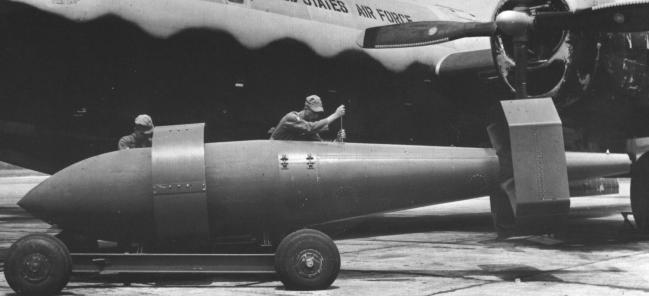
An armorer adjusts a VB-13 TARZON 13,000 lb bomb’s detachable tail. While this mechanism is essential to the bomb’s success, it is also the reason it is so dangerous for its crews.
29 March 1951
CO 19BG Col Payne Jennings, Jr. is killed along with the crew of his Boeing B-29 (45-21749) when, after losing two engines to a Soviet MiG-15 Fagot flown by Kapitán Sergey Korobov, their VB-13 13,000 lb TARZON bomb prematurely detonates during emergency release. With the failure of the VB-3 RAZON, the VB-13 was first used on 14 December 1950, with 28 strikes being flown before Jennings’s death. Another premature detonation three weeks later forces USAF leaders to reevaluate the weapon. Requiring clear weather and lower altitudes, the bomb’s effectiveness against hard targets – in Jennings’s case, a dam near Sinŭiju, North Korea – becomes questionable when noting that only 6 of the 28 successful drops destroyed their targets. Come August, the TARZON bomb - the largest conventional air-dropped bomb ever used in a time of war - is withdrawn from service.
Jennings is followed as CO 19BG by Col Adam K. Breckenridge. Breckenridge’s legacy as group commander is marred by his strict enforcement of noseart protocol. Rumored (but not confirmed) to be a product of his wife, the only documented incident where a US aircraft is censored due to public demand comes from locals protesting the noseart on Koza Kid (44-87661, 19BG). Said noseart long adored the bomber under various names, its latest name being a reference to the apparent homeliness of the Koza locals. Whatever the motive, 19BG aircraft are quickly, though begrudgingly, censored. At war's end, virtually all US bombers are scrubbed of their art before returning home. Save for a slight resurgence during DESERT STORM 40 years later, the Korean War sees the last large-scale use of noseart on US aircraft.
6 April 1951
US House Minority Leader Rep. Joseph W. Martin, Jr. (R-MA) reads aloud a private letter from CG UNC GA Douglas MacArthur sharing his views on US strategy in Korea. The Republican Party suffered heavily throughout the Roosevelt and Truman administrations, the US having a Democrat president for some 21 uninterrupted years. In Congress they fared little better, not holding both houses for nearly 64 years since 1931 (Republicans gain a majority in 1995) and failing to hold a majority during the mere four years they managed to gain it. As such, Martin is one of the few prominent Republicans in Congress and is a vocal critic of Pres. Harry S Truman (D-MO).
Reading MacArthur’s private correspondence was not wise. MacArthur was already in Truman’s bad graces, if only because Truman did not care for the man’s personality. Being a general officer for over thirty years, MacArthur was used to having a wide breath of discretion, which irritated Truman's tidy management style. When UN forces recaptured Seoul on 17 March after 72 days of occupation, Truman hoped to use the victory as the basis for a permanent ceasefire. Warned this might happen, MacArthur preemptively ordered his forces to cross the 38th Parallel again on 23 March.
Truman now set out to have MacArthur relieved of command. Evidence against MacArthur included disobeying orders (which was technically not true), his arrogance and inaccurate prognosis at the Wake Island conference, diplomatic intercepts toward Spain and Portugal warning of a possible war with China, and the Martin letter. These issues are further compounded with the fact that, on 11 April (the day of his relief), MacArthur orders USN forces under his command make a show-of-strength in the Straits of Formosa. MacArthur's relief sparks national outrage and a congressional investigation later finds MacArthur innocent of any legal wrongdoing. As a result, Truman’s popularity tanks, his approval rating being the lowest of any US president in the 20th century. MacArthur’s relief sets a precedent for civilian control of the military, discouraging debate between commanders and their civilian authorities lest they lose funding or be relieved of command – which they no longer need legal justification to suffer.
MacArthur is replaced by GEN Matthew B. Ridgway as CG UNC, with LTG James A. Van Fleet taking command of the US Eighth Army.
12 April 1951
UN FEAF BC launches 48 Boeing B-29s, escorted by 24 Lockheed F-80s, 34 Republic F-84s, and 18 North American F-86s, against the Yalu River rail bridge of Sinŭiju, North Korea. The bridge is a vital Chinese supply artery in the center of MiG Alley and the bombers are loaded with twelve AN-M66 2,000 lb bombs each, though the lead bomber carries a single VB-13 13,000 lb TARZON bomb. This is the second strike in less than a week against this target, with the previous being flown on 7 April. This previous strike was the first to use Republic F-84s as escort fighters. Rather than transfer additional F-86s to Korea (as was urgently requested), CINC SAC Gen Curtis E. LeMay urged CG FEAF Lt Gen George E. Stratemeyer transfer the 27FG - an F-84 fighter-bomber unit - to escort-duty. This was not a smart move. The F-84 is by no means equal to the task of intercepting Soviet MiGs, with its thick, straight-wing limiting maneuverability and speed. No F-84 achieved an aerial victory on 7 April, faring little better on 12 April.
The 12 April strike is a disaster. Heavy winds blow the bombers across the Chinese border, not only prompting a possible international incident but suggesting to Soviet units based at Andong (modern-day Dāndōng) that they are the intended target. In response, the Soviets scramble 36 MiG-15 Fagots, attacking bombers already spread out by high-winds and multiple target approaches. Worse, due to improper fuse settings, many US bombs fail to detonate on impact, causing minimal damage to the bridge. This is the largest B-29 strike of the Korean war and the costliest thus far. Likewise, this day's actions, which painfully expose the F-84's impotence (the 27FG, an F-84 unit, achieves only a single, unconfirmed victory throughout the entire war), solidify the F-86 as the only USAF fighter capable of engaging the MiG-15 on equal terms. Regardless, F-84s continue to fly escort duty due to the JCS's hesitation to send valuable F-86 units overseas.
Four 4FG pilots and seven B-29 gunners claim aerial victories on this day, the latter including Sgt Billy G. Beach, right waist gunner on No Sweat (44-87618, 19BG). Beach becomes a minor celebrity as the first aerial gunner to down two jet fighters, and an episode of the Cavalcade of America radio show entitled “Billy the Kid” airs in his honor on 30 December 1952 with Van Johnson in the lead role. Unfortunately, Soviet records only confirm the loss of a single fighter, a MiG-15 damaged-beyond-repair, likely through the efforts of Capt James Jabara, flying F-86A 48-259 (4FG).
The increasing vigor of Soviet units throughout April is in large part due to a Soviet campaign to train and equip Chinese and North Korean MiG pilots. This, combined with the renewed construction of North Korean airbases, convinces UN leaders to prepare for a possible Chinese offensive that summer. As such, FEAF BC begins on 17 April a steady campaign of airstrikes against North Korean airbases, finally returning to interdiction strikes on 23 April. These strikes are relatively unmolested thanks to a constant stream of F-86 patrols operating out of crude, forward airbases.
| Bombers Launched: | 48 |
| Bombers Effective: | 39 |
| Fighters Launched: | 76 |
| Bombers MIA: | 3 |
| Bombers DBR: | 2 |
| Bombers Abort: | 9 |
| Abort Rate: | 19% |
| Loss Rate: | 10% |
| E/A Destroyed: | 1 |
| Aircraft Type | Serial No. | Name | Unit |
| Boeing B-29-55-BW | 44-69682 | Hot Box | 30BS/19BG |
| Boeing B-29-50-MO | 44-86370 | Lucky Dog | 93BS/19BG |
| Boeing B-29A-70-BN | 44-62252 | 371BS/307BG |
DAMAGED BEYOND REPAIR
| Boeing B-29-80-BW | 44-87618 | No Sweat | 30BS/19BG |
| Boeing B-29-30-MO | 44-65369 | Black Sheep | 93BS/19BG |
20 May 1951
Taking part in a fighter sweep, Capt James Jabara, piloting F-86A 48-259, scores his fifth and sixth aerial victories, making him the first American ace of the Korean War and the first jet fighter ace in military history. Jabara had flown 63 sorties by this point and is immediately ordered on publicity tours of the US and Lebanon (his family's original home). Jabara returns to Korea in January 1953 and claims nine more victories by war's end flying F-86F 52-5233. Jabara is later killed in a car accident near Delray Beach, FL on 17 November 1966; Jabara is 43 years old. Jabara's legacy is tainted when declassified Soviet records contradict Jabara's claims, showing him to have achieved no more than four victories by 20 May. According to these sources, the first jet ace is Capt Dick S. Becker, piloting F-86A 49-1184 (4FG), who downs his fifth MiG on 9 September 1951.
Also on this day, CG FEAF Lt Gen George E. Stratemeyer suffers a heart attack and is placed in confinement at Tachikawa AFB's hospital. Upon recovery he undergoes mandatory retirement on 31 January 1952. He is replaced by Lt Gen Otto P. Weyland, former CG TAC, on 10 June 1951, with Maj Gen Earl E. Partridge CG 5AF acting as interim commander.
23 October 1951
UN FEAF BC launches nine Boeing B-29s, escorted by 55 Republic F-84s and 34 North American F-86s, against the airfield of Namsi, North Korea. The bombers are intercepted by 84 MiG-15 Fagots.
Despite the losses of 12 April, the April “potholing” campaign against North Korean airfields went well. North Korean airbases were attacked with such regularity by tactical follow-up strikes that they could hardly base anything more than harassment aircraft – the most famous of which were the old PO-2 “Bedcheck Charlie” biplanes. This situation changed in September when the construction of communist airbases in North Korean was renewed. Forcing another battle for air superiority over "MiG Alley," the 4FG - is already overtaxed as the sole UN fighter unit equipped with the F-86. Despite UN air forces being outnumbered five-to-one, CSAF Gen Hoyt S. Vandenberg refused to allocate any more F-86s to Korea. The official US history has this to say on the subject:
What was happening in the Far East in the summer of 1951 was one more indication of the truth in observation that in the years since World War II the United States had become fat and complacent and had dropped its guard. America’s superior technology was not yet able to match the totalitarian economy of Soviet Russia in the quantity production of swept-wing air-superiority fighters. The contrast in numbers of fighting forces in the Far East was little short of shameful.
October revealed that a trio of bases capable of housing Soviet MiGs were under construction in a 20 mi circle around the cities of Namsi (modern-day Panghyŏn), Taechon, and Saamcham (modern-day Sŏnch'ŏn). Should these bases become operational, the Soviets would be able to extend “MiG Alley” as far south as P'yŏngyang. While night operations were safer for the bombers, they were also less accurate. As such, newly promoted CG FEAF BC Brig Gen Joe W. Kelly (30 September) authorizes a daylight campaign against the airfields, starting with a successful strike against Saamchan on 18 October. Launching in thee-element groups of nine, daylight SHORAN strikes are launched against Taechon on 18 October, 21 October, and 22 October. The Soviets begin to realize US goals by the time of this last strike, with 54 MiG-15s intercepting US bombers and downing the Cream Of The Crop (44-61656, 19BG). The next day's operation against Namsi is a disaster.
The 23 October strike on Namsi is the costliest US strategic bomber operation since the Second World War, earning the nickname “Black Tuesday” amongst bomber crews. The day after sees eight B-29s, escorted by escorted by 16 Gloster Meteors (RAAF), 10 F-84s, and 20 F-86s, strike the railway of Sunch'ŏn. The strike is intercepted by 55 MiG-15s, losing yet another bomber (Our Gal, 44-61932, 19BG).
| Bombers Launched: | 9 |
| Bombers Effective: | 8 |
| Fighters Launched: | 39 |
| Bombers MIA: | 3 |
| Bombers DBR: | 2 |
| Bombers Abort: | 1 |
| Fighters MIA: | 1 |
| Abort Rate: | 11% |
| Loss Rate: | 56% |
| E/A Destroyed: | 1 |
| Aircraft Type | Serial No. | Name | Unit |
| Boeing B-29-80-BW | 44-70151 | Eddie Allen II | 370BS/307BG |
| Boeing B-29A-25-BN | 42-94045 | Liberty Belle II | 371BS/307BG |
| Boeing B-29A-55-BN | 44-61940 | Miss North Carolina | 372BS/307BG |
DAMAGED BEYOND REPAIR
| Boeing B-29-45-MO | 44-86295 | Police Action | 372BS/307BG |
| Boeing B-29-40-MO | 44-27347 | 372BS/307BG |
| Aircraft Type | Serial No. | Pilot | Unit |
| Republic F-84E-25-RE | 50-1220 | 1st Lt John W. Shewmaker | 111FS/136FG |
27 October 1951
FEAF BC launches eight Boeing B-29s, escorted by 16 Gloster Meteors (RAAF), 32 Republic F-84s, and 20 North American F-86s, against the Yalu River rail bridge of Sinŭiju, North Korea. The strike is intercepted by 62 MiG-15 Fagots, heavily damaging B-29 44-62971 (19BG), which later crash-lands at occupied-Kimpo. During the flight, three of the gunners on Command Decision (44-87657, 19BG) - Sgt Merle A. Goff (tail), Pfc Harry E. Ruch (right waist), and SSgt Michael R. Martocchia (CFC) - claim four MiG-15s. These four victories, combined with a victory claimed on 31 May, elevate Command Decision to ace status, though Soviet sources contest all five of Command Decision’s claims.
While the following day's strike sees no losses (eight B-29s against the bridge at Songchon, North Korea), the loss of five B-29s in a single month is too much to bear; after all, only six were lost in combat over Korea prior to October. That evening, CG FEAF BC Brig Gen Joe W. Kelly orders an end to all daylight bombardment operations using B-29s. Like those bombers used as spotters for night operations, FEAF BC B-29s are to now have their undersides painted black and bomb predominantly via radar. On 21 November 1951, CSAF Gen Hoyt S. Vandenberg arrives for a tour of FEAF BC installations, meeting with aircrews who argue for more F-86 escorts and the reintroduction of the Hispano-Suiza M24 20 mm autocannon. In fact, a new F-86 unit is already in the process of being converted, with the sole F-86 unit in Korea, the 4FG, now being joined by the 51FG. Famed Second World War ace Col Francis S. Gabreski takes command of the 51FG on 6 November, with the unit transitioning from the Lockheed F-80 to the F-86 in just ten days. Shockingly, the 4FG and 51FG are the only F-86 units to see service in Korea until 1953.
Command Decision is placed on display at the National Museum of the US Air Force in Dayton, OH when the museum formally opens in 1954, though her noseart is painted over for its mocking of USAF authority. Upon the museum’s acquisition of Bock’s Car (44-27297, 509BG) in late-1961, the less-famous Command Decision is disassembled and turned into a travelling exhibit. Unfortunately, the truck carrying her is involved in an auto-accident, with the trailer carrying the bomber’s fuselage losing its cargo. The damage suffered in this incident, combined with further damage from when she is salvaged via helicopter, ruins this precious artifact. Though various pieces survive in museum scrapyards, the only current display of Command Decision is an inaccurate fuselage mockup using another B-29 (44-62139) at the National Museum of the US Air Force.
| Aircraft Type | Serial No. | Name | Unit | Date |
| Boeing B-29A-40-BN | 44-61656 | Cream Of The Crop | 30BS/19BG | 22-Oct-51 |
| Boeing B-29-80-BW | 44-70151 | Eddie Allen II | 370BS/307BG | 23-Oct-51 |
| Boeing B-29A-25-BN | 42-94045 | Liberty Belle II | 371BS/307BG | 23-Oct-51 |
| Boeing B-29A-55-BN | 44-61940 | Miss North Carolina | 372BS/307BG | 23-Oct-51 |
| Boeing B-29A-55-BN | 44-61932 | Our Gal | 343BS/98BG | 24-Oct-51 |
DAMAGED BEYOND REPAIR
| Boeing B-29-45-MO | 44-86295 | Police Action | 372BS/307BG | 23-Oct-51 |
| Boeing B-29-40-MO | 44-27347 | 372BS/307BG | 23-Oct-51 |
| Boeing B-29A-60-BN | 44-62071 | 30BS/19BG | 27-Oct-51 |
27 November 1951
As part of Project NIKE, a Boeing B-17 drone is shot down by a MIM-3 Ajax Surface-to-Air-Missile (SAM) over the White Sands Missile Range of New Mexico. This is the first successful use of a SAM against an aircraft.
While AAA proved deadly during the Second World War, it was a surprisingly costly process, requiring thousands of artillery shells to down even a single bomber. And while the introduction of proximity shells improved AAA, ineffective AAA remained an issue with the rapid growth of jet-engine bombers. Noting the appearance of the German Arado Ar-234 in late-1944, US Army Chief of Ordnance MG Levin H. Campbell, Jr. called on Bell Labs to create a ground-controlled missile interceptor, forming Project NIKE on 8 February 1945. A similar project called GAPA (Ground-to-Air Pilotless Aircraft), headed by Boeing, was to focus on long-range interceptions via radar-homing missiles.
The NIKE SAM series proves radically successful and is fully implemented into the US national defense system in 1954. The Boeing system is less successful, struggling to maintain funding for what was seen as, essentially, the same concept. Joining with the Michigan Aerospace Research Center, the ultimate product of this endeavor is the CIM-10 BoMARC, which downs its first aircraft – another B-17 drone – off the coast of Florida on 23 October 1957.
15 April 1952
The first flight of the Boeing B-52 Stratofortress takes place, with test pilot A. M. "Tex" Johnston at the controls. Boeing originally designed the B-52 with turboprops, responding to a 1946 call for an intercontinental bomber akin to the Convair B-36 then entering service. A USAF meeting on 21 October 1948 at the Van Cleve Hotel in Dayton, OH however demanded that the bomber be redesigned with jet engines. Having already toyed with this possibility, aerodynamicist George S. Schairer hurriedly carved a balsa wood mockup over the weekend for the next meeting. Schairer's design, in many ways an enlarged Boeing B-47, forms the basis for all production B-52s. Federal budget cuts put the B-52 program on the backburner until 1951 when heavy losses of prop-driven Boeing B-29s to jet-powered MiG-15 Fagots over Korea suggested the need for an all-jet bomber force. As such, the B-52 finally enters production, defeating the Convair YB-60 for the bid, itself little more than a jet-powered B-36. The only significant design change made is demanded by CINC SAC Gen Curtis E. LeMay, who insists on a side-by-side cockpit to ease the transition of older bomber crews. Some 744 aircraft are built within the following decade as the B-52 quickly becomes the primary strategic bomber of the USAF. The B-52 remains in service to this day.
The image of the B-52 becomes intimately associated with thermonuclear war in American popular culture. Operations such as CHROME DOME (1960-1968), which see 24-hr B-52 patrols carrying live nuclear weapons, are a constant reminder that an atomic holocaust is a very real possibility. The cultural impact is strong, with apocalyptic science fiction, for example, becoming a staple of film and literature, with some of the more popular examples being The Day The Earth Stood Still (1951), Godzilla (1956), Planet of the Apes (1968), Silent Running (1972), and The Terminator (1984). One of the more enduring cultural images from this period is the beehive hairstyle, which due to its large size, is also called "the B-52."
Click here to see singer Kate Pierson wearing a B-52-type hairstyle.
| Powerplant: | 8x Pratt & Whitney J57 |
| 4,200 lb 12,030 lbf Axial-Flow Turbojets | |
| Armament: | 4x Browning AN-M3 Electrically-Boosted .50 Caliber MGs |
| Bombload: | 43,000 lbs |
| Cruise Speed: | 523 mph |
| Service Ceiling: | 47,300 ft |
| Range: | 7,343 mi |
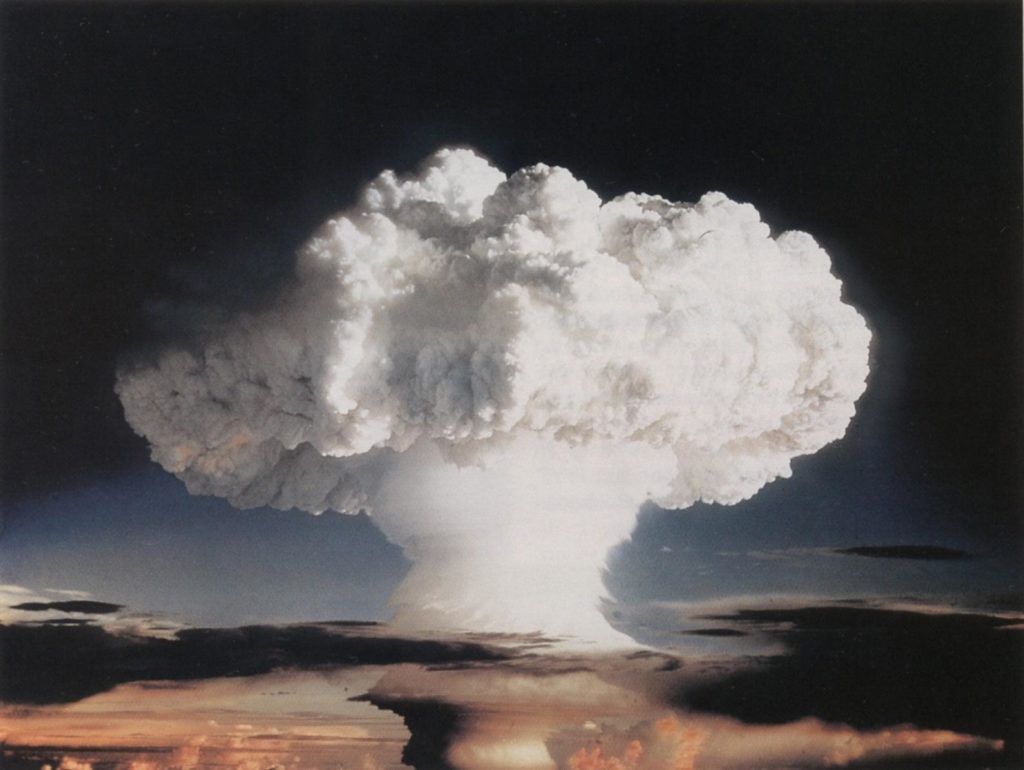
IVY MIKE, the world’s first thermonuclear weapon, explodes leaving a mushroom cloud up to 136,000 feet - twice the altitude record.
1 November 1952
Under Project IVY, the first hydrogen-based thermonuclear weapon, MIKE, is detonated on Elugelab Island in Enewetak Atoll. Rather than use a fission process against a dense material like plutonium, nuclear weapons now use a fusion process against light materials. The result is dramatic. To compare nuclear and thermonuclear weapons:
- Gadget (16-Jul-45): TNT equivalent 20 kt (44 million lbs)
- Little Boy (6-Aug-45): TNT equivalent 15 kt (33 million lbs)
- Fat Man (9-Aug-45): TNT equivalent 21 kt (46 million lbs)
- MIKE (1-Nov-52): TNT equivalent 10 mt (20 billion lbs)
24 April 1953
USAF wing-coupling experiments under Project TIP-TOW end in disaster off the coast of Long Island, NY. After three years of tests involving a Boeing B-29 (44-62093) and two Republic F-84s, the first test to utilize the critical automatic pilot system results in the left-hand fighter flipping over and crashing into the mothership. Only the pilot of the right-hand aircraft, Maj Clarence E. “Bud” Anderson, survives. The entire concept hinges on the ability of the automatic pilot to take over flying the escort, allowing the smaller aircraft to idle. The inability of this gyroscopic mechanism to hold the aircraft level while attached to the bomber suggests a simpler solution. Special, stabilizing wingtips are developed to account for this problematic turbulence and are later tested under Project TOM-TOM.
27 July 1953
The Korean War comes to an end after three years, one month, and three days. A commission from India led by Lt-Gen Kodandera Subayya Timayya oversees the armistice, with all sides agreeing, with some reservations, to Indian terms. Influencing factors include the election of Dwight D. Eisenhower (R-KS) as US president on 4 November 1952, and the death of Soviet Premier Joseph V. J. Stalin on 5 March 1953, ending Soviet support for Chinese aggression. Threats made during the talks by the Eisenhower administration suggest forming an alliance with Taiwan and using thermonuclear weapons if China failed to adhere to terms, though the effect these memos had remains hotly debated. The new armistice is in reality a ceasefire, and a state of war continues to exist between North and South Korea to this day. Boeing B-29 losses during the conflict total 34 aircraft (16 to fighters, 4 flak, and 14 to other), with their gunners claiming 27 kills, all but one of which are MiG-15 Fagots. Soviet and Chinese sources only confirm one loss each to B-29 gunners, neither of which are recognized by the US.
20 November 1953
LT A. Scott Crossfield pilots the first officially recorded flight at twice the speed of sound (1,291 mph, Mach 2.005), flying Douglas D-558-II Skyrocket 37974, dropped from the NACA Boeing P2B Fertile Myrtle (Navy B-29 no. 45-21787), out of Edwards AFB.
Douglas D-558-II 37974 is currently on display at the National Air and Space Museum in Washington, DC. Fertile Myrtle (45-21787), while disassembled, is currently the property of aviation enthusiast Kermit Weeks. A portion of the bomber is on display at Weeks's museum, the Fantasy of Flight, in Polk City, FL.
28 January 1954
Project FEATHERWEIGHT disarms the USAF’s bomber fleet in order to maximize aircraft performance, in particular the service ceiling of the Convair B-36. This idea was not entirely new. Like the SILVERPLATE program of the Second World War with its disarming of Boeing B-29s, weight remained an issue on the postwar B-36 and Boeing B-50. Removing unessential armaments seemed to be a given, particularly since jet fighters over Korea were too fast to accurately track from any position other than the tail. The B-36 particularly suffered from its heavy armament, the vibrations of its turrets being so serious that the crash of one Peacemaker (44-92035) was due, in part, to the recoil of the bomber's autocannon. If the bomber could no longer defend itself in combat, even with the aid of escorting fighters, it would have to simply outclimb the enemy. FEATHERWEIGHT has a marked impact on the performance of the B-36, and US bombers operate on this principle until the loss of Capt F. Gary Powers in 1960, though US bomber aircraft continue to be armed with tail guns until 1991.
23 November 1954
The US stock market finally returns to its pre-Depression peak-closing after 25 years, two months, and 21 days. The Great Depression is officially over. The 1950s produce an unprecedented growth in the American standard of living, with commodities like electricity and indoor plumbing finally reaching a nationwide status, as well as luxuries like refrigerators, televisions, and multiple automobiles per family. This economic gulf between the US and the Soviet Union is made particularly evident on 24 July 1959 when VP Richard M. Nixon (R-CA) meets with Soviet Premier Nikita S. Khrushchev at an exposition detailing advances in US home technology, taking the opportunity to debate each other's economic systems before the entire world. A popular joke from this period states that if Nixon wanted to prove the superiority of American capitalism, he should have taken Krushchev to a supermarket.
US economic growth in the 1950s is primarily the result of federal budget cuts by Pres. Dwight D. Eisenhower's (R-KS) administration, both in foreign and domestic affairs (so-called "guns and butter"). On 12 January 1954, Secretary of State John Foster Dulles (R-NY) announced the strategic policy of "massive retaliation," alleviating US defense responsibilities by increasing those of the US's allies and promising to respond to hostile acts by the Soviet Union with all possible force. Due to its nuclear monopoly, this places responsibility for continental defense in the hands of the USAF, with the other branches scrambling to expand their own nuclear programs. Leftist critics of the Eisenhower administration maintain that such a policy brings the world dangerously close to a nuclear holocaust, dismissing massive retaliation as "mutually-assured destruction" and framing political debates in terms of leftist "doves" and right "hawks." However, it is worth noting that the opposite appears to have been true, as the US does not become involved in any shooting-war against communism while under a Republican (i.e., "hawk") administration. By contrast, the Korean War (1950-1953), Bay of Pigs Invasion (1961), Cuban Missile Crisis (1962), and Viêt Nam War (1964-1973) all break out under Democrat (i.e., "dove") administrations.
27 April 1956
The USAF cancels Project FICON after four years of development. Despite the failure of the McDonnell XF-85, the concept of a bomber mothership remains attractive as fighter aircraft, which normally lack such long ranges, could in theory be used to conduct fast reconnaissance and tactical nuclear strikes. Tests with Republic F-84s coupling with a Convair B-36F prove promising as, while the parasite cannot entirely fit in the bombbay, it can dock with enough stability for the pilot to exit the aircraft. Ten B-36s motherships and 25 parasite F-84s are ordered, entering service in 1955 and seeing regular use as a reconnaissance platform until its cancellation in 1957 with the introduction of the Lockheed U-2 ultra-high altitude reconnaissance aircraft.
21 May 1956
As part of Operation REDWING, Boeing B-52B Barbara Grace (52-0013) conducts the first air-drop of a thermonuclear weapon (Test Cherokee). Due to a navigation error, the bomber misses its target, Namu Island of Bikini Atoll, by four mi.
Barbara Grace is currently on outdoor display, though in very poor condition, at the National Museum of Nuclear Science & History in Albuquerque, NM.
23 September 1956
USAF wing-coupling experiments under Project TOM-TOM comes to an end. The failure of automatic-pilot systems in Project TIP-TOW encouraged Convair, working independently on the same idea, to develop skewed wingtips that eliminated the need for an automatic-pilot. Tests conducted with a Convair B-36 and a Republic F-84 proved promising but required delicate handling upon mating the escort to the mothership. The project is cancelled when a mating test is conducted slightly off-plumb, resulting in violent turbulence that damages the wingtip mechanism on the B-36. The increasing numbers of aerial tankers make further funding for parasite fighter programs impractical and the concept is indefinitely shelved.
27 September 1956
Capt Milburn G. Apt pilots the first officially recorded flight at three times the speed of sound (2,094 mph, Mach 3.196), flying Bell X-2 46-675, dropped from Boeing B-50 48-096, out of Edwards AFB. Apt attempts a banking turn while still over Mach 3 and loses control; Apt is killed upon ejection. While X-2 lands with surprisingly little damage, the project is nevertheless cancelled - one of the last test programs conducted by the USAF prior to turning its experimental aircraft over to NACA.
Capt Capt Milburn G. Apt is the 13th airman killed in tests over Edwards AFB since 1950. No example of a Bell X-2 currently survives.
11 November 1956
The first flight of the Convair B-58 Hustler takes place. The B-58 is designed as a supersonic nuclear strike aircraft and incorporates several revolutionary design features to accommodate speeds in excess of Mach 2. Despite setting nineteen different speed records in its lifetime, the bomber is incredibly dependent on midair refueling despite having a shorter range than the Boeing B-47 (the aircraft it is meant to replace). The introduction of improved Soviet surface-to-air missiles (SAMs) in 1960, namely the S-75 Dvina, forces the B-58 to give up its intended role in favor of low-altitude strikes below Soviet radar. It is here that the aircraft’s flaws become apparent, coupling extreme speeds with the high-turbulence of low-altitudes. Naturally, the B-58 suffers a high accident rate (26 lost, over 22% of those produced) and, although some 116 are built, the B-58 is eventually retired from service on 31 January 1970. The B-58 never sees combat.
Eight Convair B-58 Hustlers currently survive in various museums, though only one, Cowtown Hustler (59-2458), is in pristine condition, being on display at the National Museum of the US Air Force in Dayton, OH.
| Powerplant: | 4x General Electric J79 |
| 3,850 lb 17,835 lbf Axial-Flow Afterburning Turbojets | |
| Armament: | 1x General Electric M61 Electrically Boosted 20 mm rotary cannon |
| Bombload: | 19,450 lbs |
| Cruise Speed: | 599 mph |
| Service Ceiling: | 55,900 ft |
| Range: | 4,100 mi |
2 March 1959
USAF SAC commences Operation HEAD START II, wherein nuclear-armed Boeing B-52s are kept airborne 24 hrs a day awaiting instructions for a possible retaliatory strike. This is the first of a series of similar operations, the most famous of which is called CHROME DOME.
The brainchild of CINC SAC Gen Tommy S. Power, the alert concept began under predecessor and mentor Gen Curtis E. LeMay. LeMay originally developed a program of ground alerts, beginning with Operation TRY OUT in 1956, wherein a rotating third of SAC was always on alert, ready for an emergency scramble at 15 minutes notice. Power expanded this once assuming command on 1 July 1957, with 72 hr “reflex tours” in Alaska and 90 day reflex tours in Spain, Morocco, and the UK. The concern had always been losing aircraft before they could get off the ground, so CHROME DOME type operations ensure that at least five nuclear-armed B-52s are in the air at all times. The B-52s and their tankers are later augmented with the introduction of LOOKING GLASS on 3 February 1961, which sees a flying command center, complete with a SAC general officer, kept airborne in case SAC offices in Omaha, NE are destroyed. LOOKING GLASS utilizes specially-equipped Boeing C-135s, the military variant of the Boeing 707 airliner.
The US suffers five BROKEN ARROW incidents (the accidental loss of nuclear weapons) throughout the course of CHROME DOME. Two of these are major public embarrassments when, even though the bombs never detonated, radioactive material is released via the bombs' traditional explosive components. These events - the first over Palomeres, Spain on 17 January 1966 and the second over Thule AFB, Greenland on 21 January 1968 - require extensive cleanup and result in a ban on nuclear-armed flights over these countries. The latter accident results in the permanent termination of CHROME DOME type operations. On 30 September 1971, the US and the Soviet Union sign the "Agreement on Measures to Reduce the Risk of Nuclear War," promising to alert one another in the event of a BROKEN ARROW.
| Aircraft Type | Serial No. | Callsign | Unit |
| Boeing B-52G-95-BW | 58-0187 | "Tea 19" | 4241BW |
14-Mar-61 *Fuel exhaustion over Yuba City, CA*
| Boeing B-52F-70-BW | 57-0166 | "Doe 11" | 4134BW |
13-Jan-64 *Structural failure over Frostburg, MD*
| Boeing B-52D-10-BW | 55-060 | "Buzz 14" | 484BW |
17-Jan-66 *Midair collision over Palomares, Spain*
| Boeing B-52G-115-BW | 58-0256 | "Tea 16" | 68BW |
| Boeing KC-135A | 61-0273 | "Troubadour 14" | unk |
21-Jan-68 *Fire over Thule AFB, Greenland*
| Boeing B-52G-100-BW | 58-0188 | "Hobo 28" | 380BW |
7 October 1959
Three Soviet-built S-75 Dvina SAMs, shoot down a Taiwanese Martin B-57 flying reconnaissance over Communist China. This is the first downing of an enemy aircraft using a SAM. The use of SAMs this day is covered-up by the Soviet media, the loss being officially credited to Chinese MiGs.
Soviet SAM development originated with captured Wasserfall missiles and progressed slowly in the years following the war due to political infighting. However, the outbreak of the Korean War and the heightening of political tensions convinced Soviet Premier Joseph V. J. Stalin to demand a crash program to protect Russian cities. Despite setting a one-year deadline, the first successful SAM, the S-25 Berkut (Golden Eagle), did not enter service until 1955. By that time, a more mobile variant, the S-75 Dvina, was already underway, entering service in 1957.
The first public acknowledgment of a SAM victory is made when a US CIA Lockheed U-2 (56-6693), piloted by Capt F. Gary Powers, is shot down over the Soviet Union on 1 May 1960. The incident becomes a political scandal when Pres. Dwight D. Eisenhower (R-KS) denies authorizing reconnaissance flights, after which Soviet Premier Nikita S. Khrushchev responds by publicizing not just wreckage, but the still-living Powers. In response, Eisenhower confesses to the true nature of the flights, ruining a planned peace summit. Powers is released from captivity on 10 February 1962 via a prisoner exchange with KGB agent Rudolf Abel.
| S-75 Dvina Radio-Guided SAM | |
| Warhead: | 440 lb |
| Max. Speed: | 2,685 mph |
| Effective Range: | 28 mi |
The wreckage of U-2C 56–6693 is currently on display at the Central’nyj Muzej Vooružennyh sil (Central Armed Forces Museum) in Moscow, Russia. The S-75 Dvina (Codename GUIDELINE) remains history's most heavily-produced SAM.
7 March 1961
Maj Robert M. White pilots the first officially recorded flight at four times the speed of sound (2,905 mph, Mach 4.43) flying North American X-15 56-6671, dropped from the NASA Boeing B-52B Balls Eight (52-008), out of Edwards AFB. On 17 July 1962, White sets an altitude record of 314,750 ft, technically qualifying him for the US astronaut badge and becoming something of a minor celebrity.
X-15 56-6671 is currently on display at the National Museum of the US Air Force in Dayton, OH. Its mothership, Boeing B-52B Balls Eight (52-008), is currently on outdoor display at Edward AFB near Rosamond, CA.
23 June 1961
Maj Robert M. White pilots the first officially recorded flight at five times the speed of sound (3,603 mph, Mach 5.27) flying North American X-15 56-6671, dropped from the NASA Boeing B-52A High & Mighty One (52-003), out of Edwards AFB.
X-15 56-6671 is currently on display at the National Museum of the US Air Force in Dayton, OH. Its mothership, High & Mighty One (52-003), is currently on outdoor display at the Pima Air and Space Museum in Tucson, AZ.
9 November 1961
Maj Robert M. White pilots the first officially recorded flight at six times the speed of sound (4,093 mph, Mach 6.04) flying North American X-15 56-6671, dropped from the NASA Boeing B-52B Balls Eight (52-008), out of Edwards AFB.
X-15 56-6671 is currently on display at the National Museum of the US Air Force in Dayton, OH. Its mothership, Balls Eight (52-008), is currently on outdoor display at Edward AFB near Rosamond, CA.
16 December 1961
As part of Operation FARM GATE, USAF pilots of the 1st Air Commando Group fly their first mission in tactical support of the Army of the Republic of South Vietnam (ARVN). Approved by Pres. John F. Kennedy, Jr. (D-MA) the previous month, FARM GATE is a logical extension of the Kennedy's administration's "flexible response" strategy against communism, in which communist military efforts are only met with opposition of comparable intensity. Technically operating under an advisory status, FARM GATE airmen are to train South Vietnamese personnel, equipping them with older prop-driven aircraft like the Douglas A-1, Douglas B-26, Douglas C-47, and North American T-28. In order to keep up their advisory status, US airmen are required to bring South Vietnamese personnel on all strikes, resulting in often laughable situations where hapless South Vietnamese are unwittingly flown into combat. For ARVN, Kennedy's flexible response is not enough, calling on CAS strikes to such a degree that the 1st Air Commando Group flies some 229 combat missions by 13 January 1962.
27 October 1962
Maj Rudolph Anderson, Jr. is killed when Lockheed U-2F 56-6676 is shot down by a S-75 Dvina SAM while conducting reconnaissance flights over Cuba. This incident, combined with the embarrassing capture of Capt F. Gary Powers two years prior, proves that altitude can no longer guarantee the safety of USAF operations over enemy territory.
The wreckage of U-2F 56-6676 is divided up between three museums: the Museo de la Lucha contra Bandidos (Museum of the War against the Bandits) in Trinidad, and the Museo de la Revolución (Museum of the Revolution) and Fortaleza de San Carlos de la Cabaña (Fortress of St. Charles) in Havana, Cuba.
22 August 1963
Joseph A. Walker breaks the altitude record for highest recorded manned aircraft flight, flying to 354,200 ft (approx. 67 mi up) in North American X-15 56-6672, dropped from the NASA Boeing B-52A High & Mighty One (52-003), out of Edwards AFB. Walker's record still stands today. Walker is one of eight pilots, all of the X-15, to earn the US astronaut badge; of the eight, Walker is the only one to reach the NASA standard of 328,084 ft rather than the USAF standard of 264,000 ft for outerspace flight.
56-6672's mothership, High & Mighty One (52-003), is currently on outdoor display at the Pima Air and Space Museum in Tucson, AZ.
29 January 1964
Dr. Strangelove or: How I Learned to Stop Worrying and Love the Bomb, written and directed by Stanley Kubrick, premieres to global acclaim. The film is based on the 1958 best-selling novel Red Alert by Peter B. George, though differs in taking a comedic, rather than dramatic, tone in condemning the former US policy of massive retaliation. Kubrick, ever the perfectionist, wanted the film to be as accurate as possible and consulted such noted defense analysts as Alastair F. Buchan and Herman Kahn. To this day, Dr. Strangelove is considered a superb primer on the concepts of thermonuclear strategy. The film also creates a literary trope in regard to nuclear warfare, with copycat films such as Fail Safe (1964) and By Dawn's Early Light (1990) also being rather successful.
The plot follows a chain of events after a delusional SAC wing-commander Brig Gen Jack D. Ripper (loosely based on CSAF Gen Curtis E. LeMay) launches a preemptive strike against the Soviet Union. Locking himself in his office, Ripper rants about the dangers of fluoride (a parody of the conservative John Birch Society) while a visiting British RAF officer tries to decipher the bombers’ recall codes. In Washington, Pres. Merkin Muffley (a parody of presidential candidate Gov. Adlai E. Stevenson (D-IL)) is faced with the prospect of a nuclear holocaust when he learns the Soviets possess a failsafe intended to wipeout the earth should the US launch a nuclear strike. Advised by a hawkish CSAF and ex-Nazi scientist - whose differing opinions mirror that of Kahn and then CG SAC Gen Tommy S. Power - Merkin struggles to prevent this tragedy. Finally, the film follows the crew of the B-52 Leper Colony (a reference to 12 O'Clock High (1949)) who ultimately manage to complete their terrible mission.
The film instantly becomes a classic, elevating the careers of George C. Scott and Peter Sellers, the latter playing three different roles in the film. Unfortunately, it also destroys public trust in SAC and Curtis E. LeMay, reinforcing the liberal argument that military power was unchecked under Pres. Dwight D. Eisenhower (R-KS). This attitude toward the previous administration is worsened by interservice rivalry resulting USAF favoritism. As such, Robert S. McNamara (D-CA) - SecDef under John F. Kennedy (D-MA) and Lyndon B. Johnson (D-TX) - severely micromanages the military, using funding as leverage against the JCS. This will play havoc in how these administrations handle communist expansion into South Viêt Nam.
7 August 1964
US Congress passes the Gulf of Tonkin Resolution, allowing Pres. Lyndon B. Johnson (D-TX) to use US forces in Southeast Asia as he sees fit. The resolution is passed in response to attacks on the USS Maddox (DD-731) and USS Turner Joy (DD-951), the first occurring on 2 August when they were attacked by three P-4 torpedo boats off the Viêtnamese coast. While the destroyers escaped unharmed, the event frightened their crews, who in consequence overreact to a false-alarm on 4 August. A retaliatory strike against North Viêtnamese marinas, Operation PIERCE ARROW, was launched from the USS Ticonderoga (CV-14) and Constellation (CV-64) the following day while the Johnson administration called for the resolution's passing.
The Gulf of Tonkin Resolution is but another step in a constant escalation of US involvement in Viêt Nam. While US involvement was limited to an advisory status, the attacks on the Maddox and Turner Joy serve as a harbinger of things to come. On the night of 31 October, Viêtnamese communist (Viêt Cong or VC) guerrillas mortar the US airbase at Biên Hòa (6 KIA, 19 WIA, 9 aircraft lost), and on 24 December a car bomb is detonated beneath the Brinks Hotel in Sài Gòn (2 KIA, 60 WIA). Johnson, who is up for reelection, wanes in responding to these attacks until sworn into office on 20 January 1965.
For many Americans, the passing of the Gulf of Tonkin Resolution marks the beginning of the Viêt Nam War.
1 February 1965
CSAF Gen Curtis E. LeMay is forced into early retirement by Pres. Lyndon B. Johnson (D-TX) and SecDef Robert S. McNamara (D-CA). This event takes place shortly after the retirement of CG SAC Gen Tommy S. Power on 30 November. LeMay chaffed Johnson, his predecessor John F. Kennedy (D-MA), and McNamara with his aggressive stance toward communist expansion. This ran counter to the Democratic Party's platform, which sought a flexible response rather than one of overwhelming superiority. Johnson proved less patient than Kennedy, outright rejecting LeMay's proposals to deal with North Viêt Nam by mining its waters and bombing its infrastructure. LeMay viewed Viêt Nam as a potential mire and argued that the best way to prevent such would be to eliminate North Viêt Nam's logistical apparatus, halting any further escalation. This would have meant a major naval and air campaign, the publicity of which Johnson desperately hoped to avoid, wanting the public to focus instead on his Great Society welfare program. LeMay received little support from the other service chiefs, largely due to the changing relationship between civilian and military leaders in the wake of nuclear warfare. The disastrous "Revolt of the Admirals" in 1949, the relief of GA Douglas MacArthur in 1951, and Pres. Dwight D. Eisenhower's (R-KS) heavy reliance on the USAF throughout 1953-1961, left the chiefs unwilling to vocally oppose the policies of an already loutish Johnson lest they lose precious funding. Power and LeMay are replaced by far more conciliatory men: John D. Ryan and John P. McConnell.
Curtis E. LeMay remains perhaps the most accomplished airman in military history. His rise was meteoric, being a Major General at age 37 and a Chief of Staff at age 55; LeMay's latter years unfortunately do much to tarnish his reputation. Dr. Strangelove (1964) sealed LeMay's reputation as a violent oaf and his candid nature of discussing nuclear warfare only solidifies this reputation with the media. Shortly after retiring, LeMay receives scathing media attention for his memoirs' wording on how he felt best to deal with Viêt Nam. Written with the aid of author B. MacKinlay Kantor, Mission with LeMay, states:
My solution to the problem would be to tell [North Viêt Nam] frankly that they've got to draw in their horns and stop their aggression or we're going to bomb them into the Stone Age. And we would shove them back into the Stone Age with Air power or Naval power - not with ground forces.
This selection is regularly quoted to this day despite the revelation that it was a creation of Kantor and not LeMay. In 1968 LeMay shocks family and friends by accepting the Vice Presidential nomination of George C. Wallace, Jr.'s (I-AL) presidential ticket. Wallace, an infamous racial segregationist, has little in common with LeMay, who throughout his career had worked toward racial integration, but is able to coax LeMay's attention by advocating strategies LeMay pushed for against Viêt Nam. Not surprisingly, LeMay's presence harms Wallace's already tarnished reputation, with press conferences regularly devolving into discussions on nuclear fallout. Stung by the damage to his character the association with Wallace results in, LeMay retires from public life shortly after the election. LeMay dies on 1 October 1990 at the age of 93 and is buried at the US Air Force Academy in Colorado Springs, CO - ironic considering that his military education came not from a military academy but from Ohio State University.
2 March 1965
Pres. Lyndon B. Johnson (D-TX) orders the implantation of Operation ROLLING THUNDER. A combination of two widely divergent plans drawn up by CINCPAC ADM Harry D. Felt and brothers McGeorge and William P. Bundy, ROLLING THUNDER establishes a set of predetermined targets, of which almost all are interdiction-based. Airstrikes are directed from Washington, DC, with regular presidential meetings deciding which targets are to be hit, with little to no military consultation. Target restrictions include buffers on the Chinese border, on the capital city of Hà Nội, and on the port city of Hải Phòng, North Viêt Nam, though these restrictions fluctuate throughout the course of the war. Nominally intended to destroy North Viêtnamese transportation and halt the flow of communist insurgents and supplies into South Viêt Nam, ROLLING THUNDER is in reality a means of political conditioning. By keeping a tight rein, Johnson can scale back the bombing whenever North Viêt Nam shows indications of accepting terms for peace negotiations. This ability to roll-back the strikes also allows Johnson some control over the public's perception of the war, both domestically and in communist Russia and China. Due to these concerns, strategic bombers like the Boeing B-52, and strategic targets like airfields, manufacturing plants, and the port of Hải Phòng, play little to no part in ROLLING THUNDER.
ROLLING THUNDER is a dismal failure. North Viêt Nam quickly realizes ROLLING THUNDER's methodology, using the regular bombing halts, intended as peace overtures, to repair damaged areas and import Soviet-designed aircraft, AAA, and SAM-sites. Likewise, the hesitance to bomb strategic targets results in the bombing of tactical targets while expecting strategic results. The contrast is laughable, with fighter-bombers striking targets in North Viêt Nam while B-52s fly CAS over South Viêt Nam. Aircrews loudly protest this state-of-affairs, as men and machines are increasingly lost bombing targets of little value to the enemy. In 1967 the Department of Defense concludes that more bombs were dropped by the US over North Viêt Nam than both the Korean War and the Second World War. This statistic is often cited by critics of airpower, ignoring the importance of proper targeting. ROLLING THUNDER continues until 1 November 1968, just prior to the next presidential election. (922 aircraft lost)
4 April 1965
The US 7AF launches 48 Republic F-105s against the Sông Mã River Bridge near Thanh Hóa, North Viêt Nam. The bridge is known to locals as Hàm Rồng (“Dragon’s Jaw”) for its 40 ft thick concrete. The strike is escorted by North American F-100s. This day sees the first US losses to North Viêtnamese MiGs. Known as "Aviation Day," this date becomes an official North Viêtnamese holiday.
The Johnson administration’s ROE prohibited firing on enemy aircraft outside of visual range, effectively negating the use of air-to-air missiles. This situation is worsened by communist tactics that sought to lure escorts away from their wards before attacking. As such, VPAF interceptors, vectored by GCI (ground control interception), are able to intercept F-105 fighter bombers with alarming success. Two of this day’s losses are due to MiG interception, with the one US aerial victory being achieved not by a MiGCAP, but a RESCAP fighter. This victory, made by Capt Don Kilgus flying “Green 2” (55-2894, 3FW) is the first US aerial victory of the Viêt Nam War. Pres. Lyndon B. Johnson (D-TX) is incensed by the news of a US aerial victory, and Kilgus’s claim is never officially recognized, though it is confirmed by the North Viêtnamese.
In response to the increasing presence of MiG interceptors, radar stations in South Viêt Nam and ship-based combat information centers (CIC) are tasked with monitoring Viêtnamese airspace, covering positive identification radar advisory zones (PIRAZ) to give real-time updates to US aircrews. These shipboard CICs, callsign "Red Crown," are particularly effective over North Viêt Nam but are limited by a line-of-sight detection range. Having dealt with this issue in the Second World War, areas beyond the range of surface radar are covered by AWAC (Airborne Early Warning and Control) aircraft. Known as "Big Eye" and "College Eye," these aircraft (primarily Lockheed EC-121s), are supplemented with Douglas EB-66 radar jamming aircraft, and an increased allocation of the new McDonnell-Douglas F-4 fighter to Southeast Asia.
| Aircraft Type | Serial No. | Callsign | Unit |
| Republic F-105D-25-RE | 62-4217 | "Steel 3" | 44FS/18FW |
| Republic F-105D-5-RE | 59-1754 | "Zinc 1" | 354FS/355FW |
| Republic F-105D-6-RE | 59-1764 | "Zinc 2" | 354FS/355FW |
18 June 1965
US SAC implements Operation ARC LIGHT, launching 30 Boeing B-52Fs against reported VC activity in the Bến Cát district of South Viêt Nam. This is the first combat operation of the B-52. Post-strike analysis finds that the attack destroyed 40 small buildings, a communications area, a rice shed, and two VC guerrillas. While this is a pathetic showing for an operation costing nearly $20 million, this strike's poor planning typifies the use of American airpower over Viêt Nam in the coming years. ARC LIGHT is, in many ways, a continuation of US strategy in the Korean War, using heavy bombers as flying artillery. While the B-52 has a fearsome reputation amongst the Viêtnamese, it is a costly and blunt instrument to use in the CAS role. Ground units are expected to follow the "Three Grand" rule, meaning that they must be outside the 3,000 yd impact radius to lessen the potential of friendly fire; in the heat of combat, said rule is rarely followed. During this day's strike, two bombers are lost in a mid-air collision when planners fail to space out each cell's tanker rendezvous.
CG MACV GEN William C. Westmoreland originally fought for the use of Boeing B-52s during FLAMING DART (a training-camp strike made in response to a guerrilla attack on 7 February) but was rebuffed over how the media might present its use to the American public. With permission finally given, B-52s are put to heavy use in further ARC LIGHT strikes, though they still require confirmation by the JCS in Washington, DC before launch.
| Bombers Launched: | 30 |
| Bombers MIA: | 2 |
| Loss Rate: | 7% |
| Aircraft Type | Serial No. | Callsign | Unit |
| Boeing B-52F-105-BO | 57-0047 | unk | 441BS/7BW |
| Boeing B-52F-70-BW | 57-0179 | unk | 441BS/7BW |
27 July 1965
Under Operation SPRING HIGH, the US 7AF launches 48 Republic F-105s, escorted by 8 Lockheed F-104s and 12 McDonnell-Douglas F-4s, against a pair of S-75 Dvina sites some 25 miles west of Hà Nội, North Viêt Nam. Authorized by Pres. Lyndon B. Johnson (D-TX), the strike is launched in retaliation for the loss of F-4C "Leopard 2" (63-7599, 15FW) on 24 July – the first US loss to a SAM in wartime.
US aircrews noted the construction of SAM-sites on 5 April but were prohibited from attacking as these initial units were in the 30 mi exclusionary zone dictated by ROLLING THUNDER. The initial response was to allocate Douglas B-66s to Southeast Asia, as these aircraft had long been converted for the ECM role in jamming Soviet radar. These aircraft proved quite useful though suffered from being unarmed, underpowered, and few in number. Still, this was merely a reactive measure and US airmen loudly called for strikes against NVA SAM sites. The loss of “Leopard 2” finally justifies these complaints to Johnson, though SecDef Robert S. McNamara (D-CA) prohibits attacks on the other five sites, being concerned that they might hit Soviet advisors.
The strike is a disaster. Recognizing that SAM sites are unable to track low-level aircraft (the S-75’s minimum altitude is just under 10,000 ft), SPRING HIGH is flown at tree-top height. This was anticipated, as not only are AAA emplacements placed along the familiar route, but the sites are now manned with bamboo dummies. As a result of SPRING HIGH’s failure, the US begins development of specialized anti-SAM weaponry and tactics. Regardless, low-level strikes remain a fixture of the war, with the majority of US air losses over Viêt Nam being due to AAA fire.
| Bombers Launched: | 48 |
| Fighters Launched: | 20 |
| Bombers MIA: | 6 |
| Loss Rate: | 13% |
| Aircraft Type | Serial No. | Callsign | Unit |
| Republic F-105D | 62-4252 | "Cedar 2" | 12FS/18FW |
| Republic F-105D | 62-4407 | "Dogwood 2" | 12FS/18FW |
| Republic F-105D | 62-4257 | "Heady 2" | 563FS/23FW |
| Republic F-105D | 61-0113 | "Hudson 2" | 563FS/23FW |
| Republic F-105D | 61-0177 | "Pepper 1" | 357FS/355FW |
| Republic F-105D | 62-4298 | "Pepper 2" | 357FS/355FW |
22 December 1965
Capt Allen T. Lamb and EWO Capt Jack E. Donovan, crewing North American F-100F "Spruce 5" (58-11226, 388FW), mark a SAM battery in the Red River Valley of North Viet Nam, its Republic F-105 support aircraft successfully destroying the target. A Suppression of Enemy Air Defense (or SEAD) strike, this event marks the beginning of Operation WILD WEASEL.
Soviet-built S-75 Dvinas accounted for some 15% of ROLLING THUNDER losses, with the first US SAM loss being McDonnell-Douglas F-4C "Leopard 2" (63-7599, 15FW) on 24 July. SEAD operations, previously low-priority, suddenly took on a new importance. WILD WEASEL is an extension of Operation IRON HAND, a program started on 12 August 1965 to suppress North Vietnamese air defenses through jamming and misdirection. WILD WEASEL takes this a step further, forming special units whose sole purpose was to encourage SAM sites to track them so that the same signal could be used to locate and destroy the sites. When told of his bait role in the mission, Donovan, a former Boeing B-52 EWO, famously replied, “You gotta be shitting me.” This phrase quickly becomes the motto of WILD WEASEL crews.
WILD WEASEL operations vastly improve after the introduction of the AGM-45 Shrike anti-radiation missile, first being used on 18 April 1966. Homing in on the source of the SAM site’s tracking radar, communist personnel quickly learn to turn off their equipment during Shrike launches. This issue is corrected with the introduction of the AGM-78 ARM, first used on 10 March 1968, as the ARM carries a guidance system which remembers the origin of its signal target. The AGM-78 is replaced by the AGM-88 HARM in 1985, with dedicated WILD WEASELs remaining in service until 1996 when replaced by multipurpose platforms.
11 April 1966
US SAC implements Operation ROCK KICK II, launching 30 Boeing B-52Ds against the Mụ Giạ Pass of the Viêtnamese Hồ Chí Minh trail. Veering through the neighboring countries of Laos and Cambodia, the Hồ Chí Minh trail is a crude series of supply lines supporting communist guerrillas in South Viêt Nam. The success of the trail lay in the knowledge that, due to opposition in the American media, any attack against the Laotian or Cambodian side of the trail would be interpreted as an escalation of the war. As such, this strike - the first B-52 operation against North Viêt Nam - is carefully orchestrated to only bomb the North Viêtnamese side of the border (an area known as Route Pack 1). American media agencies immediately pounce upon the operation, wildly inflating it as the largest bomber operation since the Second World War. In reality, the bombers are not allowed anywhere near North Viêt Nam's major cities, which are located far beyond the new bomb-line just north of the 17th Parallel.
This strike is also the first to utilize the Boeing B-52D, the B-52Fs having returned home the previous month. These aircraft are camouflaged and carry a massive 60,000 lb bombload in comparison to the B-52F’s 43,000 lbs. This increased payload is achieved through the BIG BELLY program, making room for heavier conventional loads by removing nuclear-strike hardware and utilizing a pre-load magazine system.
Despite ROCK KICK II causing massive landslides, the Mụ Giạ Pass is reported operational the following day. Follow-up strikes are launched on 17 April (Operation BIG KITE) and 25 April, achieving similar results. Despite pleas from CG MACV GEN William C. Westmoreland to continue B-52 strikes into the monsoon season, CINC PAC ADM U. S. Grant Sharp, Jr. overrules further heavy bomber operations against the pass, citing the speed at which the roads are repaired, the increasing number of SAM sites appearing in the region, and the media concerns about the war expanding into Laos.
| Bombers Launched: | 30 |
| Bombers Effective: | 29 |
| Bombers Abort: | 1 |
| Abort Rate: | 3% |
8 June 1966
A photoshoot on behalf of engine-manufacturer General Electric ends in disaster when a Lockheed F-104 collides with the North American XB-70 Valkyrie with which it was flying formation. Test pilots Joseph A. Walker (of the altitude record fame) and Carl S. Cross are killed and Alvin S. White nearly looses his arm when ejecting from the XB-70. White is the sole survivor. This midair collision garners unfavorable attention toward the already controversial Valkyrie, leading to its final retirement in 1968.
Designed to meet an order placed in 1955 to combine the speed of the Convair B-58 with the payload of the Boeing B-52, the XB-70 first flew on 21 September 1964. While Soviet SAMs forced the US to abandon high-altitude nuclear strikes, the success of the supersonic Lockheed SR-71 showed speed could be an effective means of security. As such, the XB-70 is also designed to fly at speeds in exceed of Mach 3. Unfortunately, the XB-70's necessity was in question as land-based nuclear missiles began to enter service. Famously referring to aircraft spending as akin to "talking about bows and arrows at a time of gunpowder," Pres. Dwight D. Eisenhower (R-KS) placed the program on hold for much of his administration. As such, the XB-70 program became an issue during the 1960 election, with Sen. John F. Kennedy (D-MA) demanding the bomber's necessity due to the so-called "missile gap" (the belief that the US lacked as many nuclear missile-sites as the Soviet Union). Upon Kennedy's election and the subsequent revelation that there was, in fact, no missile gap, Kennedy continued Eisenhower's hold on the program. The XB-70 program's survival was largely due to CSAF Gen Curtis E. LeMay, who fought for the bomber under the logic that manned aircraft, unlike missiles, could be recalled.
The sole surviving example of a North American XB-70 Valkyrie, 62-0001, is currently on display at the National Museum of the US Air Force in Dayton, OH.
| Powerplant: | 6x General Electric J93 |
| 3,800 lb 28,800 lbf Axial-Flow Afterburning Turbojets | |
| Bombload: | 25,000 lbs (never tested) |
| Cruise Speed: | 1,988 mph (Mach 2.6) |
| Service Ceiling: | 75,500 ft |
| Range: | 4,290 mi |
29 June 1966
Maj Fred L. Tracy, piloting Republic F-105D “Crab 2” (58-1156, 388FW), shoots down a VPAF MiG-17 Fresco over Hà Nội, North Viêt Nam. This aerial victory is the first to use the General Electric M61 20 mm rotary cannon. Tracy’s element was flying WILD WEASEL in support of a 46-strong F-105 strike on the oilfields outside of Hà Nội when his group was attacked. Damaged by gunfire, Tracy was unable to activate his afterburner for a quick escape and so, when the MiG overshot him, Tracy destroyed it using his external mounted 20 mm cannon.
The rotary cannon concept began in 1946 under Project VULCAN as a means to upgrade US aircraft armament. The US was the only major power to not use 20 mm autocannon in quantity during the Second World War. Autocannon were unreliable and suffered from low rates-of-fire, leading the US to favor the Browning AN-M2 .50 cal. MG. The Korean War's low victory ratio revealed the limitations of using MGs in the jet age. In a genius move, General Electric revived the 19th century ideas of Richard J. Gatling, using an electrically-powered series of rotating gun-barrels to keep the barrels relatively cool while violently increasing the rate-of-fire. Despite the success of this design, few aircraft actually carry it, with many postwar fighters not carrying any gun whatsoever. This faith in missile-technology was based on the belief that future engagements would be Beyond Visual Range (BVR), but SecDef Robert S. McNamara's (D-CA) Rules of Engagement (ROE) prevented US airmen from engaging unless their targets were visually identified - negating BVR tactics and requiring gun-based dogfighting. In response, hastily designed "gun pods" were attached to US fighter aircraft until new variants arrived with an internal gun. This day's victory is achieved using one of these pods. The M61 Vulcan rotary cannon remains in use today.
| Browning AN-M2 .50 Caliber MG (12.7 mm) | |
| Rate of Fire: | 800 rpm |
| Muzzle Velocity: | 2,910 ft/s |
| Effective Range: | 2,500 yd |
| Hispano-Suiza M24 Autocannon (20 mm) | |
| Rate of Fire: | 650 rpm |
| Muzzle Velocity: | 2,850 ft/s |
| Effective Range: | 2,000 yd |
| General Electric M61 Rotary Cannon (20 mm) | |
| Rate of Fire: | 6,000 rpm |
| Muzzle Velocity: | 3,450 ft/s |
| Effective Range: | 2,200 yd |
2 January 1967
CO 8FW Col Robin Olds implements Operation BOLO, personally leading 58 McDonnell-Douglas F-4s on a CAP over North Viêt Nam. This is the costliest day for the communist airpower in the Viêt Nam War.
Hit and run attacks on Republic F-105s were a constant nuisance since the appearance of Soviet-built interceptors on 4 April 1965, with F-105s eventually just dumping their ordnance and outrunning the antiquated MiG-17 Frescos. This changed with the arrival of MiG-21 Fishbed interceptors in 1966, which could easily keep pace with the F-105s. Considering that ROLLING THUNDER strikes were launched with despicable predictability (routes, targets, etc.), something needed to be done. BOLO solves this issue by taking advantage of the routineness of F-105 operations, using the same patterns, routes, and formations – even the same radar-jamming pods - to lure the MiGs into the air where they can intercepted by F-4s.
VPAF interceptors are taken by complete surprise, with US airmen downing seven of the 16 MiG-21s known to be in North Viêtnamese custody (communist sources acknowledge five of these victories). BOLO-type operations continue on a smaller scale for the next few days, with 6 January seeing two more MiG-21 victories. While complete air supremacy over North Viêt Nam is never established during the war, the North Viêtnamese are nevertheless slow to recover from this setback.
31 August 1967
A Senate investigation, chaired by Sen. John C. Stennis (D-MS), publishes a report based on a series of hearings which began on 9 August, investigating Operation ROLLING THUNDER and its handling by the administration of Pres. Lyndon B. Johnson (D-TX). Two and a half years of bombing operations against North Viêt Nam seemed to accomplish nothing and frustrations over the lack of progress, both throughout the military and civil population, were reaching a head. Called by former Secretary of the Air W. Stuart Symington, Jr. (D-MO), now serving as a senator, the hearings publicly cover issues regularly raised against the Johnson administration's restrictions: bombing Hà Nội, mining the port of Hải Phòng, and targeting the Hồ Chí Minh trail beyond Viêtnamese borders.
The hearings damn the Johnson administration, with senior officers in theater and members of the JCS nearly unanimous in their grievances. While acknowledging that ROLLING THUNDER was crucial to the success of US operations thus far, they assert that these restrictions, coupled with their regular halts in launching peace feelers, only prolonged the conflict. Johnson had attempted to soften the publicity blow by expanding the authorized target list beforehand, though this accomplished little. SecDef Robert S. McNamara (D-CA) – who had by now abandoned any hope of success in Viêt Nam, much less aerial bombardment – is alone in his defense of ROLLING THUNDER’s handling. His position was certainly not helped by the imposition of a restriction radius around Hà Nội, motivated by a yet another peace feeler, the day before his testimony.
McNamara’s coldness to the committee did not help the situation and statements from Johnson and McNamara claiming to have a good relationship with the JCS nearly spurs these officers to resign in protest (only prevented by one who refused to go that far). McNamara resigns from office on 29 February, with the exact nature of his departure a matter of debate. When anti-war candidates gain favorable attention during the Democratic Party primaries, Johnson halts ROLLING THUNDER in its entirety on 1 November 1968 in the hopes of opening peace talks. This works and despite a massive effort to end the war prior to the election, South Viêtnamese president Nguyễn Văn Thiệu stalls, knowing that the Republican frontrunner, Richard M. Nixon (R-CA), would take a harder line against the Communists. North Viêt Nam would not be the target of a major bombing campaign for another three and half years.
Click here to read the Stennis Committee's Summary Report on Air War Against North Vietnam.
3 October 1967
Maj William J. "Pete" Knight breaks the speed record for fastest recorded manned aircraft flight, flying at Mach 6.72 (4,520 mph) in North American X-15 56-6671, dropped from the NASA Boeing B-25B mothership Balls Eight (52-008), out of Edwards AFB. Knight's record still stands today. Another X-15, 56-6672, is destroyed in an accident on 15 November, killing Maj Michael J. Adams. With the test aircraft obviously beginning to suffer from age, the X-15 program is cancelled the following year.
56-6671 is currently on display at the National Museum of the US Air Force in Dayton, OH. Its mothership, Balls Eight, is currently on outdoor display at Edward AFB near Rosamond, CA.
17 July 1969
Capitán Fernando Soto Henríquez, piloting F4U-5N Corsair FAH-609 (BuNo. 124715), shoots down a pair of Salvadoran FG-1 Corsairs while leading a patrol near Tegucigalpa, Honduras. El Salvador flung itself into a four-day war over Honduras’s crackdown on immigration, the preceding riots giving the conflict its name: the Soccer War. Both sides use surplus US aircraft left over from the Second World War, and Soto leaves the conflict a Honduran national hero, achieving three aerial victories (two Corsairs and a single North American P-51) in two days. Soto’s final victory, killing Capitán Guillermo Reynaldo Cortez, is the last known example of a prop-driven aircraft downing another in aerial combat.
Capitán Fernando Soto's Corsair, FAH-609 (BuNo. 124715), is currently kept on outdoor display at the Museo del Aire de Honduras in Tegucigalpa, Honduras.
7 April 1972
CG US 7AF Gen John D. Lavelle is forced into early retirement. Upon taking command in 1971, Lavelle chaffed at the restrictive ROE originally imposed by the Johnson administration (1963-1969). While critical of the ROE, the new administration under Pres. Richard M. Nixon (R-CA) failed to implement any real changes, leading SecDef Melvin R. Laird (R-WI) to suggest on 8 December 1971 that Lavelle make extensive use of the "protective reaction" loophole - the rule that allowed airmen to strike targets that posed any mortal threat at that given time. Noting the increased number of SAMs in North Viêt Nam, Lavelle encouraged his airmen to falsify after-action reports to read that their attacks were reactionary. As such, USAF pilots could strike any target they wished so long as the targets were classified as legitimate threats. This cumbersome practice immediately paid dividends, gaining tacit approval from CG MACV Gen Creighton W. Abrams, Jr. and allowing US air power to finally operate with some effectiveness in the Viêt Nam War.
The increase of protective-reaction strikes did not go unnoticed, notably by Peter Osnos of the Washington Post, and was ultimately uncovered when SSgt Lonnie D. Franks revealed the practice to Sen. Harold E. Hughes (D-IA). An Air Force investigation confirmed the falsified reports and Lavelle is forced into early retirement as a public scapegoat. A media firestorm damns the Nixon administration, suggesting senior airmen are free launch nuclear weapons at will as in Dr. Strangelove (they could not). Lavelle is forced to undergo extensive congressional investigation, with Abrams condemning Lavelle and pleading ignorance when later confirmed as CSA. Regardless of the media fallout, these same practices continue in Lavelle's absence as the old ROE are slowly phased out to prevent another scandal.
10 May 1972
US Pres. Richard M. Nixon (R-CA) authorizes OPERATION LINEBACKER, launching a massive interdiction campaign against North Viêt Nam. Peace talks were going poorly, with the communist insurgency spreading considerably into Laos and Cambodia. Nixon’s plan to achieve “peace with honor” through “Viêtnamization” – i.e., supplying South Viêt Nam while gradually withdrawing US servicemen – only served to highlight the power vacuum left by the dwindling number of US forces. Aided by the onset of the troublesome monsoon season, North Viêt Nam launched a massive conventional offensive against South Viêt Nam on 30 March 1972.
ARVN forces struggled to contain the communists without adequate US support, with the number of US forces in Viêt Nam now barely a third of that of the North Viêtnamese. Nixon’s advisers discouraged him from taking a hard stance, citing the improving relations with Communist China and the Soviet Union, and it is worth noting that both nations had advised North Viêt Nam against launching the offensive. In the end, Nixon decided to support South Viêt Nam, mining the harbor of Hải Phòng with Operation POCKET MONEY on 9 May and opening LINEBACKER the following day.
LINEBACKER differs significantly from ROLLING THUNDER in that the Nixon administration purposely leaves its planning and execution in the hands of the military. Boeing B-52s operate over North Viêt Nam for the first time in force and fighter ROE are noticeably relaxed. Cut off from maritime imports, LINEBACKER seeks to cut North Viêt Nam off from land supply routes, destroying bridges and storage areas, as well as seeking out and eliminating communist air bases and SAM sites. LINEBACKER is a massive success and it is worth noting that all five US aces of the Viêt Nam War (two pilots and three RIOS) achieve such status during the campaign. LINEBACKER is brought to an end on 23 October when North Viêtnamese officials agree to recognize the Nguyễn Văn Thiệu's presidency of South Viêt Nam.
The communists use this ceasefire to resupply and rearm, which is revealed to the world on 22 November when B-52D “Olive 2” (55-0110, 96BW), damaged by a S-75 Dvinia, crashes attempting to return to its base in Thailand. “Olive 2” is the first combat loss of a B-52. VPAF officials are quick to claim it in the person of MiG-21 Fishbed pilot Vũ Đình Rạng, ignoring the fact that Rạng's "interception" was claimed two days earlier.
In regard to aerial victories, it is worth noting that US kill ratios dropped during the Viêt Nam War and the USN and USAF each took different routes in dealing with this problem after ROLLING THUNDER. The Navy concluded its pilots had grown too dependent on aerial missiles, establishing its Fighter Weapons School (or TOP GUN) in Miramar, CA on 3 March 1969 to teach the dying art of dogfighting. By contrast, the USAF sought a technological solution, improving existing missile systems and demanding internal guns on future fighters, but despite this effort, LINEBACKER sees the Air Force kill ratio continue to drop. As a result, the USAF opens RED FLAG on 15 July 1974, a fighter weapons school designed to teach fighter crews how to dogfight dissimilar aircraft.
18 December 1972
US Pres. Richard M. Nixon (R-CA) authorizes Operation LINEBACKER II after North Viêt Nam rejects demands made by South Viêt Nam at the Paris Peace Accords on 14 December. North Viêtnamese officials stalled hoping for more favorable terms with the coming of a Democrat-controlled US Congress in January. Fearing the potential loss of American POWs and knowing that said Congress is likely to halt supplies to South Viêt Nam, LINEBACKER II is intended to force an agreement before this takes place. Nixon had deployed a force of 207 Boeing B-52s – 54 based at U-Tapao RTAFB, Thailand and 153 at Andersen AFB, Guam – to Southeast Asia, comprising nearly half the USAF’s entire bomber fleet. This night sees 129 Boeing B-52s strike the airfields of Kép, Hòa Lạc, and Phúc Yên, the supply dumps of Kinh Môn, and the Yên Viên railyards and radio station of Hà Nội, North Viêt Nam. LINEBACKER II is supported by a plethora of minor operations and is the largest wartime use of the B-52 - not to mention the only strategic usage of heavy bombers in the Vietnam War.
North Viêtnamese officials signal their willingness to negotiate on 26 December and 29 December, with LINEBACKER II being halted on 30 December. A 36-sortie daily cap is set on ARC LIGHT operations and bombing is restricted to below the 20th Parallel. The Paris Peace Talks resume on 8 January 1973. While 26 US aircraft were lost in a period of 11 days, the results of LINEBACKER II are readily apparent. Over a quarter of North Viêt Nam's oil capacity and 80% of their electrical power was destroyed, with US POWs noting an immediate improvement in treatment. Likewise, some 884 PAVN S-75 Dvina SAMs were fired for the loss of 15 B-52s, giving the communists a success rate just under 2%. A marked decrease in the number of SAMs fired was noted as early as 27 December, the North Viêtnamese having squandered their supply by launching in salvos of 6-8 missiles. Regardless of these facts, the majority of Western media outlets endorse North Viêt Nam's narrative, claiming some 1,400 dead civilians. These numbers have never been substantiated, nor have ridiculous "baby-killer" claims that orphanages were deliberately targeted.
The night of 20 December sees the heaviest losses, losing six of the 99 launched. The reason for this is poor planning, with SAC HQ in Omaha, NE planning strikes rather than personnel in Southeast Asia. Waves of cells are flown behind one another - same speeds, same altitudes, same approaches. Performing nuclear-style PTTs into headwinds up to 138 mph, PAVN SAM operators fire blindly into the approach path knowing they are likely to cause damage. B-52Gs are particularly susceptible, lacking the ECM equipment of the D-models, and as such, are quickly shifted to ARC LIGHT operations. Morale plummets overnight, with maintenance and health problems doubling alongside threats of mutiny, prompting CG 17th Air Division Brig Gen Glenn R. Sullivan to bypass his CO, CG 8AF Maj Gen Gerald W. Johnson, and directly contact CINC SAC Lt Gen John C. Meyer regarding poor tactical planning. Sullivan’s actions, though vital, violate military protocol and he retires two years later without promotion. Sullivan is the highest profile in a series of complaints and, doubtless aided by a furious Nixon over the losses of 20 December, responsibility for mission planning is finally given to Johnson starting 26 December. Strikes are reduced in scale until the needed changes are made, which include multiple approaches and reduced time-over-target periods.
Meyer's tenure as CINC SAC is unusual as he was a fighter pilot and had little experience with bombers. As such, Meyer is remarkably inept at understanding bomber operations. Addressing Guam-based crews on 3 January, an attempt to reintroduce the threat of court-martial for evading SAM attacks (rather than staying with the formations) results in a walkout, with the remaining airmen erupting into a frenzy:
Of the roughly 200 that remained, 75 to 80 people just went crazy. They picked up whatever was nearby and threw it at the stage - flight computers, briefing books, Coke cans, folding chairs, you name it. It was like if you had ever been to a burlesque house, where they’d throw tomatoes and apples at a bad act, it was just like that. It couldn’t have lasted more than 13 seconds, the assault, but [Meyer] got hit a bunch of times. I saw a Coke can bounce right off his head. I was just frozen in my tracks - I couldn’t do anything - it was mob action. He went down on a knee, and a bevy of colonels picked him up and helped him off stage. Meanwhile, the guys jumped up on stage and physically chased him down to the flight line. There were a bunch of guys running after him, including the guys that were “gone” and the others of us that just wanted to see what would happen. He was in his staff car, heading toward his airplane, a shiny silver and white VC-135. They chased him down to where they now have the B-52 [Arc Light Memorial] up on a pedestal. They ran down and they threw chunks of gravel that were next to the road, just pelting his staff car and the power cart [used to start engines], and continued to pelt him as he went up the ramp. Then off he went and we never heard anything more from CINC SAC.
All of the 15 B-52s lost during LINEBACKER II are hit by SAMs. Regardless, communist nations credit VPAF pilots Thiéu Tå Phạm Tuân and Trung úy Vũ Xuân Thiều with downing B-52Ds "Ebony 2" (56-0674, 307BW) and "Cobalt 1" (56-0605, 43BW). Supposedly, Tuân earned his victory using a pair of K-13 missiles on 26 December, while Thiều rammed his in a suicide attack on 27 December. Both claims are unlikely and are not recognized by the USAF. Nevertheless, Vũ Đình Rạng, Phạm Tuân, and Vũ Xuân Thiều are the only airmen ever credited with downing B-52s, and as a result, Tuân becomes a Communist celebrity, earning the Ho Chi Minh Order, the Order of Lenin, and the title Hero of the Soviet Union, before becoming a cosmonaut on Soyuz 37.
Aerial gunners SSgt Samuel O. Turner, aboard B-52D "Brown 3" (56-0676, 307BW) and A1C Albert E. Moore, aboard B-52D "Ruby 3" (55-0083, 307BW), manage to each down a MiG-21 Fishbed on the nights of 18 December and 24 December, respectively. At altitude, the MiGs are no more maneuverable than the bombers, and with the vast array of electronic countermeasures in the air, VPAF interceptors are forced to rely on traditional pursuit curves. Unfortunately for these MiGs, they are in range of the B-52’s .50 caliber MGs long before they can return fire. The radar-guided tail guns of the B-52s are astonishingly accurate and these are the only victories made by aerial gunners following the Korean War.
Click here to listen to “Lilac 2” cockpit audio of 26 December 1972
18-Dec-72
| Bombers Launched: | 129 |
| Fighters Launched: | 63 |
| Jamming Aircraft Launched: | 22 |
| Wild Weasels Launched: | 17 |
| Bombers MIA: | 3 |
| Fighters MIA: | 1 |
| Loss Rate: | 2% |
| E/A Destroyed: | 1 |
| SAMs Launched: | ≈200 |
19-Dec-72
| Bombers Launched: | 93 |
| Fighters Launched: | 63 |
| Jamming Aircraft Launched: | 22 |
| Wild Weasels Launched: | 17 |
| SAMs Launched: | ≈180 |
20-Dec-72
| Bombers Launched: | 99 |
| Bombers Effective: | 90 |
| Fighters Launched: | 55 |
| Jamming Aircraft Launched: | 26 |
| Wild Weasels Launched: | 18 |
| Bombers MIA: | 6 |
| Bombers Abort: | 9 |
| Abort Rate: | 9% |
| Loss Rate: | 6% |
| SAMs Launched: | ≈220 |
21-Dec-72
| Bombers Launched: | 30 |
| Fighters Launched: | 23 |
| Jamming Aircraft Launched: | 9 |
| Wild Weasels Launched: | 13 |
| Bombers MIA: | 2 |
| Loss Rate: | 7% |
| E/A Destroyed: | 1 |
| SAMs Launched: | unk |
22-Dec-72
| Bombers Launched: | 30 |
| Fighters Launched: | 27 |
| Jamming Aircraft Launched: | 15 |
| Wild Weasels Launched: | 15 |
| Fighters MIA: | 1 |
| SAMs Launched: | ≈43 |
23-Dec-72
| Bombers Launched: | 30 |
| Fighters Launched: | 12 |
| Jamming Aircraft Launched: | 3 |
| Wild Weasels Launched: | 13 |
| SAMs Launched: | ≈5 |
24-Dec-72
| Bombers Launched: | 30 |
| Fighters Launched: | 22 |
| Jamming Aircraft Launched: | 16 |
| Wild Weasels Launched: | 16 |
| E/A Destroyed: | 1 |
| SAMs Launched: | ≈19 |
26-Dec-72
| Bombers Launched: | 120 |
| Bombers Effective: | 118 |
| Fighters Launched: | 34 |
| Jamming Aircraft Launched: | 23 |
| Wild Weasels Launched: | 18 |
| Bombers MIA: | 2 |
| Bombers Abort: | 2 |
| Abort Rate: | 2% |
| Loss Rate: | 2% |
| SAMs Launched: | ≈68 |
27-Dec-72
| Bombers Launched: | 60 |
| Fighters Launched: | 32 |
| Jamming Aircraft Launched: | 23 |
| Wild Weasels Launched: | 23 |
| Bombers MIA: | 2 |
| Loss Rate: | 3% |
| E/A Destroyed: | 2 |
| SAMs Launched: | unk |
28-Dec-72
| Bombers Launched: | 60 |
| Fighters Launched: | 28 |
| Jamming Aircraft Launched: | 23 |
| Wild Weasels Launched: | 7 |
| SAMs Launched: | ≈48 |
29-Dec-72
| Bombers Launched: | 60 |
| Bombers Effective: | 59 |
| Fighters Launched: | 33 |
| Jamming Aircraft Launched: | 25 |
| Wild Weasels Launched: | 11 |
| Bombers Abort: | 1 |
| Abort Rate: | 2% |
| SAMs Launched: | ≈23 |
18-Dec-72
| Aircraft Type | Serial No. | Callsign | Unit |
| Boeing B-52G-110-BW | 58-0246 | "Peach 2" | unk/2BW |
| Boeing B-52G-100-BW | 58-0201 | "Charcoal 1" | 340BS/97BW |
| Boeing B-52D-75-BO | 56-0608 | "Rose 1" | 346BS/99BW |
20-Dec-72
| Boeing B-52D-35-BW | 56-0669 | "Straw 2" | 2BS/22BW |
| Boeing B-52G-80-BW | 57-6481 | "Brass 2" | 69BS/42BW |
| Boeing B-52G-100-BW | 58-0198 | "Olive 1" | 325BS/92BW |
| Boeing B-52G-95-BW | 58-0169 | "Tan 3" | 340BS/97BW |
| Boeing B-52D-80-BO | 56-0622 | "Orange 3" | 348BS/99BW |
| Boeing B-52G-85-BW | 57-6496 | "Quilt 3" | 744BS/456BW |
21-Dec-72
| Boeing B-52D-1-BW | 55-0050 | "Blue 1" | 20BS/7BW |
| Boeing B-52D-15-BW | 55-0061 | "Scarlet 3" | 2BS/22BW |
26-Dec-72
| Boeing B-52D-70-BO | 56-0584 | “Ash 1” | 346BS/99BW |
| Boeing B-52D-35-BW | 56-0674 | “Ebony 2” | 716BS/307BW |
27-Dec-72
| Boeing B-52D-75-BO | 56-0599 | "Ash 2" | 77BS/28BW |
| Boeing B-52D-75-BO | 56-0605 | "Cobalt 1" | 441BS/320BW |
18-Dec-72
| Aircraft Type | Serial No. | Callsign | Unit |
| General Dynamics F-111A | 67-0099 | "Snug 40" | 430FS/474FW |
22-Dec-72
| General Dynamics F-111A | 67-0068 | "Jackal 33" | 429FS/474FW |
27-Dec-72
| McDonnell-Douglas F-4E | 67-0234 | "Vega 2" | 4FS/432FW |
| McDonnell-Douglas F-4E | 67-0292 | "DeSoto 3" | 13FS/432FW |
29 June 1973
Liberal US senators Clifford P. Chase, Jr. (R-NJ) and Frank F. Church III (D-ID) oversee the Congressional approval of an amended appropriations bill that demands an end to all US military involvement in Southeast Asia by 15 August 1973. Originally introduced in August the previous year, the amendment is reintroduced with the convening of a Democrat-controlled Congress on 3 January. The bill is passed in the House on 26 June (325-86) and the Senate on 29 June (73-16). Since both of these margins are high enough to overrule a presidential veto, Pres. Richard M. Nixon (R-CA) signs the bill on 1 July.
Congressional restraint on the war is intensified on 7 November when Congress overrides a veto by Pres. Richard M. Nixon (R-CA) to pass the War Powers Resolution. The resolution requires a US president to notify Congress within 48 hrs of committing US forces abroad, furthermore limiting such police actions to a period of no more than 60 days. The idea behind said resolution is to force a sitting president to call for a Congressional declaration of war rather than commit US forces to an extended conflict a la Korea and Việt Nam unilaterally.
9 August 1974
US Pres. Richard M. Nixon (R-CA) resigns from the presidency amidst the controversy of the Watergate scandal. The scandal began with the arrest of five men attempting to bug the Democrat party offices in the Watergate Hotel complex on 17 June 1972. Washington Times reporters Carl Bernstein and Bob U. Woodward began an investigation into the arrests, linking the break-ins to the Nixon administration through the secret aid of FBI Assistant Director W. Mark Felt. (Felt held a grudge against Nixon for not naming him as J. Edgar Hoover’s successor after the director’s death the previous May.) As the story built-up steam, Congressional investigation discovered the existence of a presidential audio recording system, subpoenaing the tapes in the autumn of 1973. Nixon resisted, culminating in impeachment hearings on 9 May 1974 and a Supreme Court ruling on 24 July 1974 that demanded the tapes be turned over. A tape proving Nixon’s involvement was released on 5 August 1974 and Nixon resigned four days later to avoid further impeachment hearings.
This scandal, along with the Case-Church Amendment and War Powers Resolution, seals the fate of South Việt Nam, Cambodia, and Laos. US military aid to South Việt Nam drops from $2.2 billion in 1973 to $700 million in 1975, with Congress resolutely defiant in committing any US military assistance. Cambodia falls to communist forces on 17 April 1975, South Việt Nam on 30 April 1975, and Laos on 2 December 1975.
10 April 1975
US Pres. Gerald R. Ford, Jr. (R-MI) addresses a joint session of Congress, begging them to hold true to his predecessor’s commitment to supply South Việt Nam in the face of North Viêtnamese invasion. The televised address is met with extreme hostility by the antiwar left and several members of Congress walk out during Ford’s speech. In the end, Ford’s proposal is denied by a wide margin (75-17). On 21 April 1975, South Viêtnamese Pres. Nguyễn Văn Thiệu resigns from office, citing the lack of promised US support; two days later, Ford states in a college address that the Việt Nam War is over “as far as America is concerned.”
Click here to read Pres. Gerald R. Ford, Jr.’s address to the Congress.
30 April 1975
Sài Gòn, the capital of South Việt Nam, falls to communist North Viêtnamese forces and is renamed Ho Chi Minh City. The previous day saw the remaining US forces open Operation FREQUENT WIND, airlifting via helicopter 1,373 US and 5,595 South Vietnamese citizens out of South Việt Nam. This ignominious event brings an end to the Việt Nam War after 19 years, 5 months, and 29 days. Direct US involvement in the war had lasted 8 years, 5 months, and 20 days before concluding with the signing of the Paris Peace Accords on 27 January 1973.
On 23 May 1975, Pres. Gerald R. Ford, Jr. (R-MI) oversees the passage of the Indochina Migration and Refugee Assistance Act, allowing some 138,969 South Viêtnamese refugees to enter the United States. This is but little balm to upcoming events. Over the next 30 years some 3 million Viêtnamese, Cambodian, and Laotian people attempt to flee the region as “boat people,” with some 200,000 dying from drowning, capture, and/or imprisonment. Another estimated 250,000 are killed in communist “reeducation camps” set up in South Việt Nam, while some 3 million are slaughtered in the Cambodian Genocide of 1975-1979.
2 August 1990
Seeking to eliminate debt incurred in the costly Iran-Iraq War (1980-1988), Iraqi ground forces – comprising the fourth largest army in the world – invade the nation of Kuwait. Disputes over a shared border and competition over oil prices gave rise to a great deal of tension between Iraq and its financially-thriving neighbors, with accusations of ‘economic warfare’ being particularly pointed toward Kuwait and Saudi Arabia. Kuwait, already seen by many Iraqis as a illegitimate nation, is in no position to resist the coming onslaught. This notably brutal invasion (over a thousand civilian casualties) takes only two days to compete and with it, Iraq gains control of nearly a fifth of the world’s oil production – a financial boon.
Backed by a significant number of Arab nations, the UN immediately condemns Iraqi President Saddam Hussein Abd al-Majid al-Tikriti and calls for the withdrawal of his forces from Kuwait. Bolstered by British PM the Rt Hon Margaret H. Thatcher, US Pres. George H. W. Bush announces Operation DESERT SHIELD on 7 August, consolidating UN forces on the border of Kuwait and Saudi Arabia should Saddam’s invasion go further. While nearly three quarters of this “coalition” consists of US troops, nearly half of the 34 Coalition nations involved are Muslim-controlled. This uneasy alliance – purposely designed to exclude Israel as a means of placating Muslim anti-Semitism – is necessary to maintain the use of Saudi Arabia as a base, whose nation holds two of the faith’s three holy cities.
With a blockade forming in the Persian Gulf and the largest military alliance since the Second World War taking root in Saudi Arabia, Saddam Hussein is given the deadline of 15 January 1991 to abandon Kuwait. This withdrawal does not take place.
16 January 1991
The US 8AF (Lt Gen E. G. “Buck” Shuler, Jr.) launches seven Boeing B-52Gs against Iraq as part of Operation SENIOR SURPRISE: while the particulars remain classified, the targets primarily constitute hydroelectrical and telecommunication centers in cities such as Mosul, Musayyib, and Basra, Iraq. Led by Lt Col John H. Beard aboard Petie 3rd (58-0177, 2BW), the bombers drop 35 AGM-86C cruise-missiles, each carrying a 3,000 lb warhead. This strike, based at Barksdale AFB near Boosier City, LA, is the first USAF operation to bomb a foreign target from the continental US (CONUS), the bombers flying some 14,000 mi and refueling four times via Boeing KC-135s and McDonnell-Douglas KC-10s (34 hours, 30 mins). SENIOR SURPRISE, known amongst crews as “Secret Squirrel,” is the first Coalition airstrike of Operation DESERT STORM.
Classified for a year, Secret Squirrel is also the first use of the AGM-86 as a conventional air-launched cruise missile (CALCM) rather than as a nuclear weapon. Conceived following the reactionary media-frenzy over Operation EL DORADO CANYON - a 1986 strike in retaliation for a Libyan terrorist attack on West Berlin - each bomber carries seven AGM-86Cs on its underwing pylons in attempt to maximize accuracy and limit civilian losses. All but four missiles launch, each being guided to target by a Global Positioning System (GPS) – another first.
With the B-52G model already in the process of being replaced by the B-52H, all but two Secret Squirrel BUFFs are scrapped by the end of 1991. The survivors are El Lobo II (58-0185), currently on outdoor display at the Air Force Armament Museum in Destin, FL, and Valkyrie (58-0183), currently on outdoor display at the Pima Air & Space Museum in Tucson, AZ.
| Aircraft Type | Serial No. | Name | Callsign | Unit |
| Boeing B-52G-95-BW | 58-0177 | Petie 3rd | "Doom 31" | 596BS/2BW |
| Boeing B-52G-120-BW | 59-2564 | "Doom 32" | 596BS/2BW |
| Boeing B-52G-125-BW | 59-2582 | Grim Reaper II | "Doom 33" | 596BS/2BW |
| Boeing B-52G-75-BW | 57-6475 | Miami Clipper II | "Doom 34" | 596BS/2BW |
| Boeing B-52G-110-BW | 58-0238 | Miss Fit II | "Doom 35" | 596BS/2BW |
| Boeing B-52G-95-BW | 58-0183 | Valkyrie | "Doom 36" | 596BS/2BW |
| Boeing B-52G-95-BW | 58-0185 | El Lobo II | "Doom 37" | 596BS/2BW |
17 January 1991
Boeing B-52G Midnight Rendezvous (58-0248, 93BW) is severely damaged this night in a freak friendly-fire incident. Part of an interdiction strike against Iraqi forces, the bomber was flying nap-of-the-earth when an escorting McDonnell-Douglas F-4G WILD WEASEL fired an AGM-88 HARM against a suspected AAA site. Instead, the missile tracked the tail gunner's AN/ASG-15 fire control radar. While not a direct hit - the bomber is, after all, a moving target - the shrapnel is nevertheless enough to sever the tail gun assembly. No one is injured and the bomber safely lands in Jeddah, Saudi Arabia, being eventually repaired and returned to service under the new name In HARM's Way.
While there is no official correlation between the events, it is generally believed that this was the impetus behind CG SAC Gen George L. Butler ordering the removal of tail guns from the B-52 fleet on 16 September 1991. While Butler is a controversial figure, his decision is easy to understand: the gunnery system on the B-52G had not changed since the aircraft's introduction, and by this point the B-52 was over 30 years old. The radar itself was even older, being first developed for the Boeing B-29B in 1945. As such, maintaining this system - which ran on vacuum tubes in an age of increasingly digital technology - was regarded as prohibitively expensive considering the rarity of parts. The B-52 is the last US bomber to carry an aerial gunner, though Soviet-built bombers continue to carry tail guns to this day.
26 February 1991
Iraqi forces flee in the wake of the Coalition offensive, clogging the six lanes of Highway 80 connecting Kuwait to Iraq. A Grumman A-6 strike clogs the highway, trapping the retreating Iraqis within. Throughout the night, tactical airstrikes bomb the retreating Iraqi forces attempting to escape the traffic jam. While 28 armored vehicles are counted within the column, the vast majority of the 300 odd vehicles attacked are stolen from civilians, with many attempting to escape off-road into the desert.
Despite public opinion showing no distaste for the event, the media is apoplectic, referring the bombing as the “Highway of Death.” CJCS Gen Colin L. Powell later claims that media coverage of the “Highway of Death” was the primary reason for ending the Gulf War, stating the media “was starting to make it look as if we were engaged in slaughter for slaughter’s sake.”
It should be noted that, despite the war's massive Coalition success, relations between the media and the US military were notoriously poor. Veterans of the Viêt Nam War argued, with good reason, that the media played a significant role in said war's communist victory, and as such, were determined to now keep the press at arm's length. Strict restrictions were placed on what information was given to the press and while this had a positive effect on the battlefield, it embittered media coverage. Aided by a youth nostalgic for the 1960s counter-culture, the "Highway of Death" - while strategically sound - is a convenient contrast to the "video-game" type footage shown at military press briefings.
While a tactical operation rather than a strategic one, the media fallout from this event is perhaps an appropriate note on which to end this timeline.

